
Published on June 2nd, 2017 | by Assoc Editor

Foiling and Foil Shapes, a Beginner’s Guide
Published on June 2nd, 2017 by Assoc Editor -->
by Mark Chisnell, Land Rover BAR The rules covering the design and construction of the team’s America’s Cup Class (ACC) boat have defined many of the parts of the boat, including the hull and crossbeams (together called the platform), and the wing shape and size. What’s left for the team’s designers and engineers to work on is principally the daggerboards and rudders, and the control systems that operate them along with the wingsail.
A lot of the technology that goes into the control systems is hidden well inside the hull, with just glimpses of the HMI (human machine interface) that the sailors use to control the board rake, wing trim and so on. The foils are on full view however, so we thought a beginners guide to ACC foil design would come in useful now the racing is approaching.
Basic Principles The foils use exactly the same scientific principles as an aircraft wing. Just as an aircraft wing will lift a plane up off the ground, the foils of an America’s Cup Class boat will lift it out of the water. Wings are foils too, called aerofoils because they work in air. The foils on the new America’s Cup boats are more accurately called hydrofoils, because they work in water.
The secret to both types of foil is the shape – aerofoils and hydrofoils use a special shape to guide the wind or water around them, and generate the lifting force to get planes and boats up in the air. Of course, the America’s Cup boats also use an aerofoil. The main wingsail works exactly the same way as an aircraft wing, it’s just rotated to stand up straight, rather than lie flat.

While an aircraft needs an engine to push the air over the wing fast enough to generate enough force to lift the aircraft up off the ground, the wingsail on the Cup boat generates force from the wind blowing past it. The harder the wind blows, the more force it makes to push the boat forward. When the boat is going fast enough, the hydrofoils will then be able to create enough force to lift the boat out of the water. This reduces resistance to the forward motion and the boat goes faster still.
There are four hydrofoils on the boat — we count the rudders at the back because they have small wings at the tips called elevators. However, the real power to keep the boat in the air comes from the hydrofoils (the daggerboards, as you will often hear them called by the sailors) and we will concentrate on these.
The L-Foil The L-foil is exactly that; a vertical daggerboard shaft that goes through the hull of the boat, with a single horizontal hydrofoil on the bottom, the whole thing shaped like an ‘L’. If nothing else changes, then the L-foil keeps generating lift as the boat goes faster and so the boat keeps rising, and as it rises, less and less of the daggerboard is in the water.
At the basic level, two things then happen: firstly, the boat starts to slip sideways because there is less of the vertical part of the daggerboard in the water and this makes the boat feel unstable and hard to steer. Then, ultimately, if the boat keeps rising the horizontal part of the board that is doing all the lifting will break the surface. If it does, there will be a catastrophic loss of lift and the boat will come crashing back down.
Aircraft use moving parts on the foils to control the amount of lift – trailing edge flaps — but the rules forbid these on the ACC boats, so to maintain stable flight the sailors change the rake or angle of attack of the whole dagger board (and hence the foil) to the water.
Rake If you rake the board backwards as the boat accelerates, the lift will reduce and the boat will come to an equilibrium at a steady height above the water. This is all well and good until the conditions change, maybe the wind speed goes up or down, or the boat hits some waves. When that happens the rake will need further adjustment to find the new equilibrium… until the next puff or lull when it must change again.
In the big breeze and rough water of San Francisco Bay in the 34th America’s Cup it turned out that these moments of equilibrium didn’t last very long and on occasions barely existed at all. The crew’s ability to generate the hydraulic power to change the board and wing trim was simply overwhelmed; they couldn’t achieve stable flight.
V-foil The solution was what’s called the V-foil, in which the horizontal part of the ‘L’ is angled upwards to form more of a ‘V’ shape (the angle at the bottom of the ‘V’ is called the dihedral – a dihedral of 90 degrees would define an L-foil, less than that is progressively more of a V-foil).
The V-foil uses the same principle as one of the most successful original foiling powerboats. The grand old man of 19th century innovation, Alexander Graham Bell put a couple of 350hp engines on the back of what was called HD-4 and set a new marine world speed record in 1919 of just over 70mph.
HD-4 used three ‘ladders’ of small foils, one at the front, and one each side close to the back. When the boat accelerated it started to lift out of the water, and as it lifted, one by one the ‘rungs’ of the foils would break clear of the water. As they did so the lift would decrease, and unless the boat continued to accelerate the boat would stop rising and settle at an equilibrium.
The V-foil achieves this same effect with a single foil and is used in the commercial application of fast ferries— one runs between Southampton and Cowes on the Isle of Wight, right across the Solent waters where the team train, and has done so (on and off) since 1969 – so V-foils are well understood.
When a boat equipped with a V-foil keeps rising as more lift is generated by faster speeds, both parts of the ‘V’ come out of the water together. Critically, when the ‘horizontal’ section starts to break the surface at the tip, it has the effect of reducing the lift gradually, because it doesn’t all come out of the water together. So the boat comes back down gently, working towards an equilibrium ‘ride height’ of its own accord.
It might be that it doesn’t reach this equilibrium before something else changes, but the V-foil has some inherent stability (unlike the L-foil) that doesn’t require human intervention. The shape provides a feedback mechanism to control the amount of lift and produce a more stable ride at a consistent height above the water. The downside of the V-foil is that it will generate less lift and more drag than the L-foil under the same conditions, because some of the lift generated is pushing sideways rather than up.
So one of the big questions facing the teams at the outset of this campaign was whether or not the sailors could achieve stable flight with an L-foil in the new boats and the new venue. Bermuda was a very different place to San Francisco; the winds were expected to be lighter, the water flatter and it seemed that stable flight should be easier to achieve with an L-foil under human control.
A huge amount of work has gone into foil and control system design and we now know that the answer is yes, they can – all the teams are using L-foils, often with unloaded dihedral angles of greater than 90 degrees. These angles close as the boat sails and the foil is loaded up to become much closer to, or 90 degrees.
Cant Another buzz word for the 35th America’s Cup is the cant. The cant of the board is similar to the rake, except that the bottom of the board is moving sideways across the boat, to and from the centreline, rather than backwards and forwards. When the board is canted outwards (towards the edge of the boat) it creates greater ‘righting moment’ and more power to drive the boat forwards.
Righting Moment When the wind hits a sail it creates the force to move the boat forward but it also creates a force that is trying to tip the boat over. If you have ever seen a dinghy or yacht knocked flat by a big gust of wind then you’ve already got the idea.
It’s considerably simplified, but essentially the more force that can be applied to resist the wind’s effort to tip the boat over, then the faster the boat will go, because more of the wind’s energy can be captured and applied to forward motion. The resisting force is called the righting moment and creating as much righting moment as possible is a fundamental principle of designing fast sailboats. It’s the reason that you see people leaning over the windward side when they are racing, putting bodies as far out on the windward side as possible is creating righting moment.
S-Foil Finally, there’s the question of whether the vertical part of the daggerboard should be straight or ‘S’ shaped. The curve of the S-foil could be used — like the cant — to move the bottom of the board outboard and increase the righting moment. So S-foils are more powerful, but they are also more difficult to use. The curves have to raised up and down through the bearings and internal mechanisms in the hull, and that means a lot of work to keep the friction down and the efficiency high.

Tags: AC35 , America's Cup , foiling , Land Rover BAR , Mark Chisnell
Related Posts
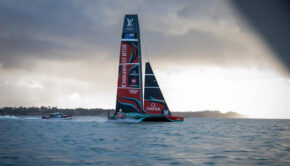
Defending the America’s Cup offshore →
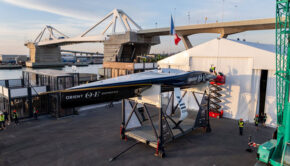
French join America’s Cup splash party →
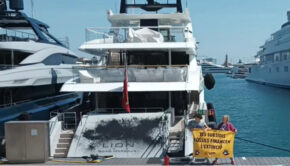
Activists threaten America’s Cup security →

Ep10: Road to the 37th America’s Cup →
© 2024 Scuttlebutt Sailing News. Inbox Communications, Inc. All Rights Reserved. made by VSSL Agency .
- Privacy Statement
- Advertise With Us
Get Your Sailing News Fix!
Your download by email.
- Your Name...
- Your Email... *
- Email This field is for validation purposes and should be left unchanged.

- BOAT OF THE YEAR
- Newsletters
- Sailboat Reviews
- Boating Safety
- Sailing Totem
- Charter Resources
- Destinations
- Galley Recipes
- Living Aboard
- Sails and Rigging
- Maintenance

Hydrofoils for Sailboats
- By By Steven Callahan
- Updated: July 29, 2020
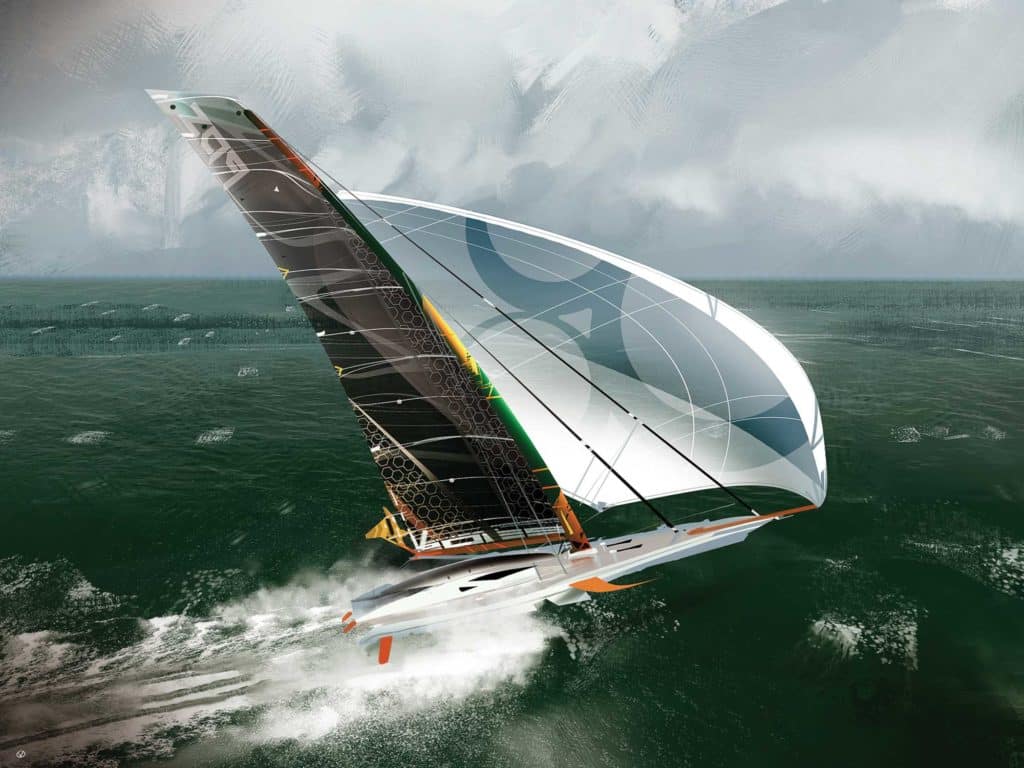
Hydrofoils have been providing dynamic lift since fish sprouted fins. And people have been employing foils ever since they first put paddle to water, and certainly since adding keels and rudders to boats. But the modern, flying America’s Cup boats, kiteboards, Moth dinghies, shorthanded offshore thoroughbreds—these are all playing in a new world in which the terms “hydrofoils” or “lifting foils” describe those oriented to raise a hull or hulls from the water. In these racing realms, if you ain’t got foils, you ain’t got nothin’.
Lifting foils that allow these boats to sometimes home in on three times the wind speed might appear to be of little interest to cruising sailors, but with such common cruising features as self-steering and autopilots, self-tailing winches, rope clutches, fin keels and faster hull shapes all having been passed down from the racing scene, one must ask, “What promise, if any, do hydrofoils hold?”
Lifted or partially lifted boat patents extend back to 1869, but workable watercraft took roots along with early flight. Italian Enrico Forlanini began experimenting with foils in 1898. In 1906, his 1-ton 60 hp foiler reached 42.5 mph. Alexander Graham Bell’s HD-4 Hydrodrome flew on Bras d’ Or Lake at 70 mph in 1919. And several sailing foiler patents began appearing in the 1950s. Notably, JG Baker’s 26-foot monohull, Monitor, flew at 30-plus mph in 1955. Baker experimented with a number of foil configurations, and at least built, if not used, the first wing mast. The first offshore foiler was likely David Keiper’s flying trimaran, Williwaw , in which he crisscrossed the Pacific in the 1960s.
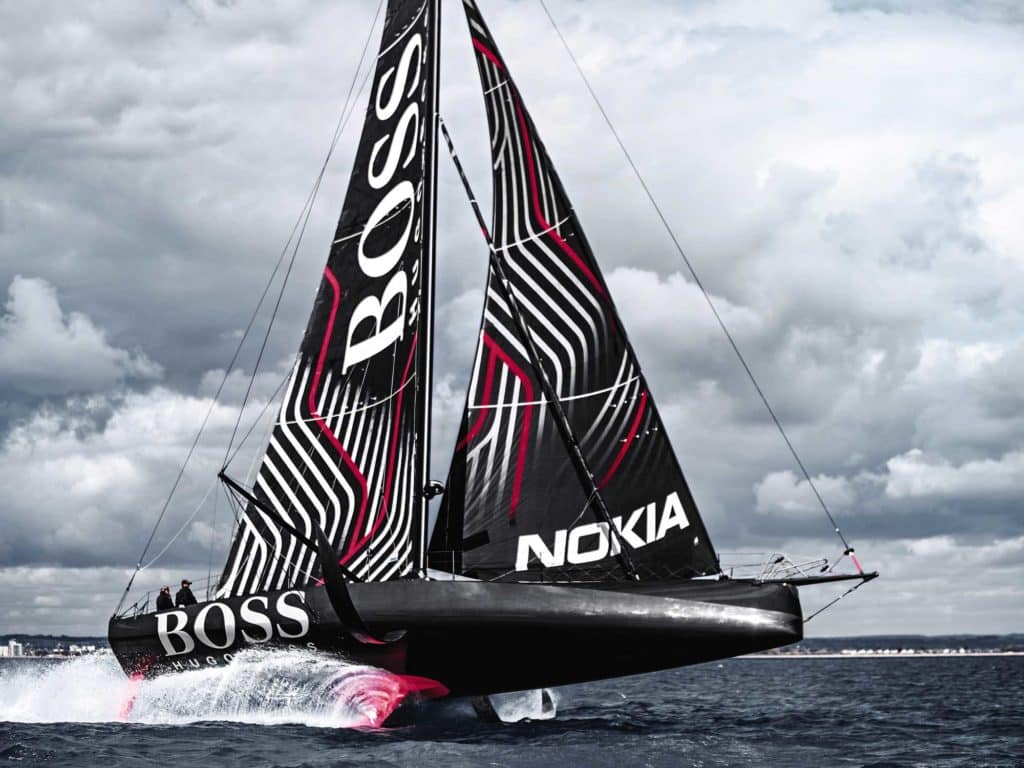
By the 1980s, numerous speed-trial and foil-enhanced offshore-racing multihulls showed huge promise, and have since evolved into behemoth trimarans clocking 30 to 40 knots continuously for long periods, not to mention the monohulls in the Vendée Globe (and soon the Ocean Race) that are capable of speeds exceeding 30 knots. But as boat designer Rodger Martin once reminded me, “If you want a new idea, look in an old book.” He was right. The fully foiling monohulls that will compete in the 2021 America’s Cup will bring things back full circle to the foiling monohull Monitor .
Fluid Dynamics Primer
Any foil—a wing, sail, keel, rudder or lifting foil—redirects the flow of fluid (air included), creating high- and low-pressure areas on opposite sides of the appendage, while developing lift perpendicular to the foil’s surface.
Advancements in foiling science is due in part to the hundreds of foil shapes that were tested, with tabulated results, by the National Advisory Committee for Aeronautics, the forerunner of the National Aeronautics and Space Administration. For the better part of a century now, aircraft and boat designers have been able to choose from a spectrum of refined foil sections that produce predictable amounts of lift and drag for known speeds of fluid and angles of attack, or the angle at which the foil passes through the fluid. Sections of efficient faster foils, as seen on jets or as we flatten our sails to go upwind or reach high speeds, have smaller nose radii and are thinner, with the thickest section of the foils farther aft, up to nearly halfway toward the trailing edge.
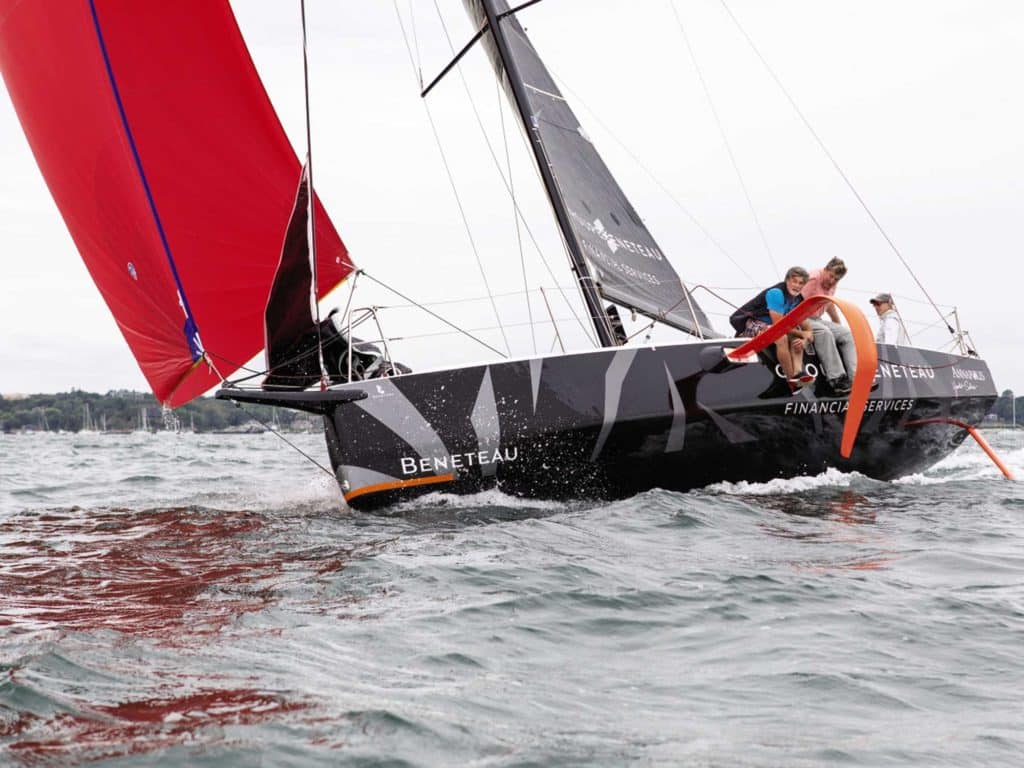
The most efficient foil sections at slow speeds are fatter, with the maximum thickness farther forward, and with larger nose radii, than faster foils. The angle to fluid flow or angle of attack also is greater. We see these slower foils on wings of prop planes and sails when off the wind or in light conditions.
Most sailors are familiar with traditional foils on boats, the teardrop sections of keels that produce lift to weather, reducing leeway, and of rudders, allowing them to steer. Even a flat plate can be a foil, but these tend to be inefficient. Such a shape is prone to fluid separation from the surface, meaning they stall easily, and they maintain poor lift-to-drag ratios. Even keels and rudders are somewhat lift-compromised because they are symmetrical and have to work with fluid coming from either side, whereas lifting foils are more like aircraft wings or propellers, with asymmetrical sections honed for performance in a more stable, fluid flow.
The point is, any foil can be employed at various angles to the surface to prevent leeway, produce increased stability, or help lift the boat out of the water. But those not required to work with fluid flowing from opposite sides can then be honed to maximize lift and minimize drag. Asymmetrical foils were used on boats like Bruce King’s bilgeboarders, including Hawkeye , back in the 1970s. And, designers, including Olin Stephens, had previously employed trim tabs behind keels to improve keel performance.
Sails, which are heeled airfoils, not only drive the boat forward, but they also produce downforce, actually increasing the dynamic displacement of the boat. To counter this and keep the boat sailing more upright, multihull designer Dick Newick first employed slanted asymmetrical hydrofoils in the outer hulls of his small charter trimaran, Lark , in 1962. A portion of the lift developed by the hydrofoil resisted leeway, while a portion worked to actually lift the leeward hull, keeping the boat more upright and reducing dynamic displacement and drag.
Anyone who has ridden on even a foil-stabilized boat will know how riding at least lightly on the waves, and especially above them, beats smashing through them. When boats lift off, everything gets a lot smoother, drag falls away, and the boat accelerates.
Cruising on Foils
But why would a cruiser want to whip over the sea? Wouldn’t this demand an inordinate amount of attention by the crew? Would lifting foils even be applicable to a boat that must have substantial displacement to carry crew and stores? Aren’t cruising-boat hydrofoils an oxymoron?
Maybe, but I believe our boats’ hulls are likely to sprout fins much as fish have as we orient foils to more efficiently resist leeway, add stability, aid steering, reduce drag, increase comfort, allow for shallower draft, and enhance wider variations in hull shapes.
Boats have gotten increasingly wide through the years to advance form stability, improve performance (primarily off the wind), and boost interior volume. But the downside is that fat boats tend to slam more upwind. What if you could reduce dynamic displacement of the boat and lift that hull even partially from the water? The result would be less slamming, especially upwind.
At the same time, what about narrower boats that are known for being more seakindly, especially when closehauled, but lack form stability to carry adequate sail area for powering upwind, and tend to roll badly downwind? Or shallow-draft vessels that are lovely for cruising, but again, tend to suffer from reduced stability? Foils can give that stability back.
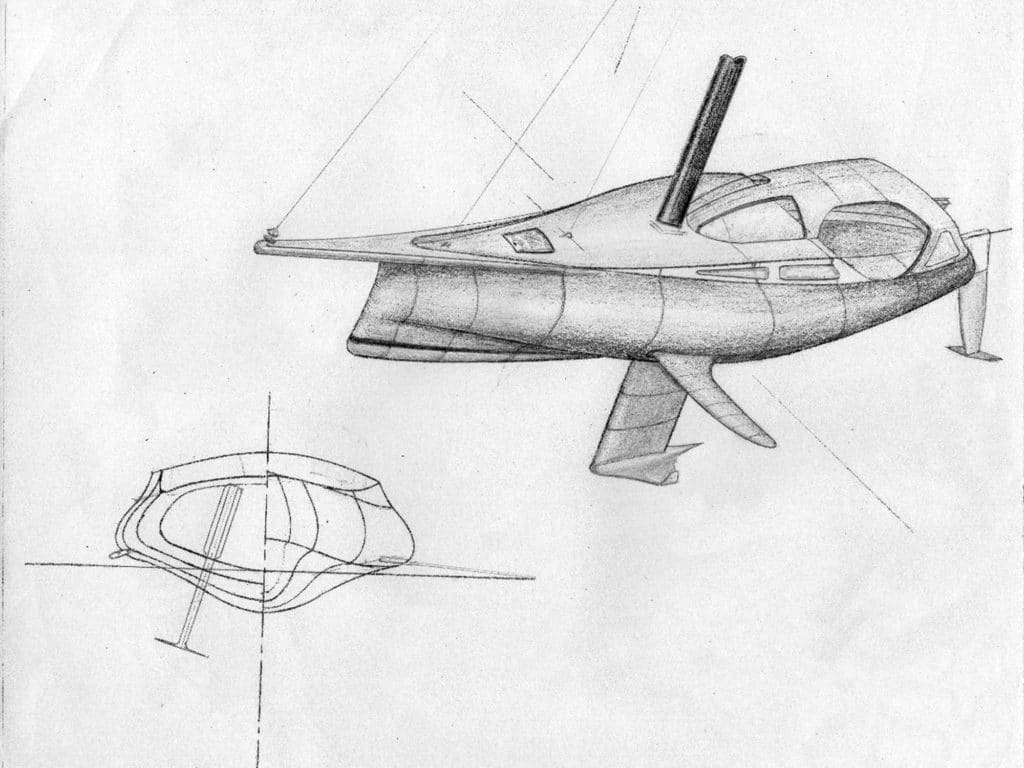
Looking ahead, boat designers might choose to reduce ballast, making up for it with a foil. In short, lifting foils can reduce boat drag and motion while increasing power and performance.
Pitching also does no favors for speed or crew comfort. Foils can come into play here as well. Foils parallel to the sea’s surface resist motion up and down, and a lifted boat skating above chop also is less prone to hobby-horsing through waves. Multihulls have always been particularly susceptible to pitching for a number of reasons, but watching videos of multihulls sailing to weather show an obvious huge advantage that foilers have compared with nonfoilers. Offshore multihulls now routinely employ T-foils on the rudders to control the fore and aft angles of the boat (attitude), a feature easily adaptable to any vessel.
OK, so what’s the cost? Obviously, the more things sticking through the hull, especially if they are retractable, the more it’s going to impact the interior. There would be added weight, complexity and cost. Foils also create noise, and there’s susceptibility to damage from hitting stuff. And let’s not forget compromises with shapes, purposes and things not yet imagined.
As for damage, it’s possible to fold the foils back into the hull. Think swinging center- boards or actual fish fins. Daggerboardlike foils can at least employ shock-absorbing systems similar to the daggerboard arrangements found in many multihulls. This includes weak links that are outside the hull, so if a foil is struck, it frees the foil to fold back or to come off before being destroyed or damaging the hull. Or, foils might hang from the deck rather than penetrating the hull, allowing them to kick up (and to be retrofitted to existing boats). These configurations also relieve the interior of intrusions, and keep the noise more removed from it. I have no doubt that numerous talented designers will be exploring all kinds of options and compromises in coming years, finding ways to make foils both practical and more than worth the compromises.
Sailing more upright, shallower draft, speed, comfort—what’s not to like? Just what is possible? I have a feeling the cruising community is about to find out.
Steven Callahan is a multihull aficionado, boat designer and the author of Adrift , an account of his 76 days spent in a life raft across the Atlantic.
- More: foils , How To , hydrofoils , print june july 2020 , sailboat design
- More How To
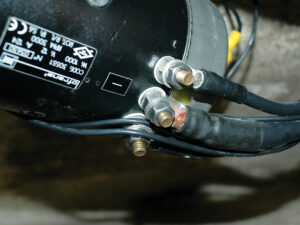
How to Keep Your Windlass Working For You
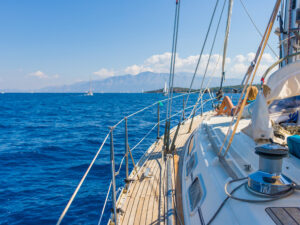
Southern Comfort: Tactical Tips for Sailing South
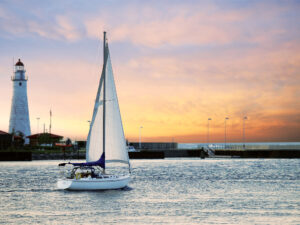
Preparing to Head Out
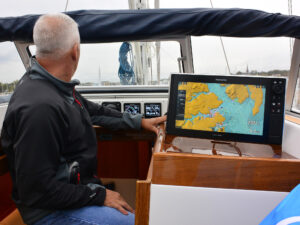
Adding Onboard Electronics? Here’s How To Get Started
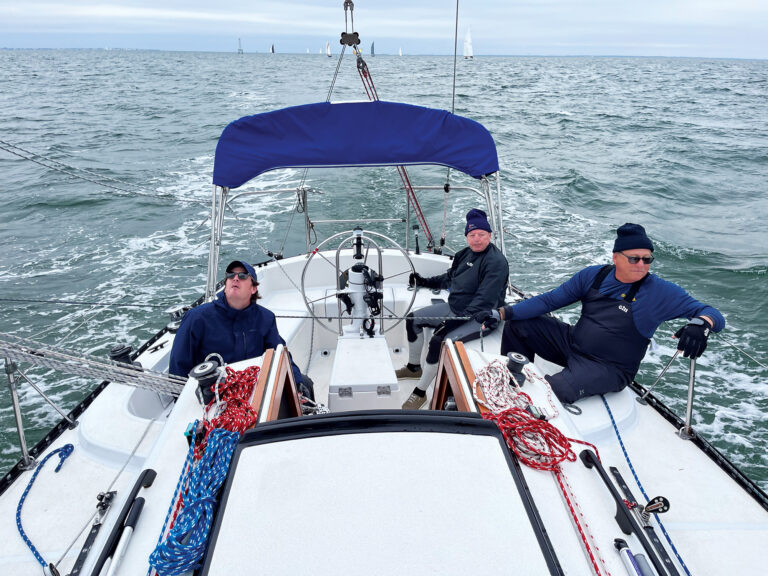
The Re-creation: My Day at the St. Pete Regatta
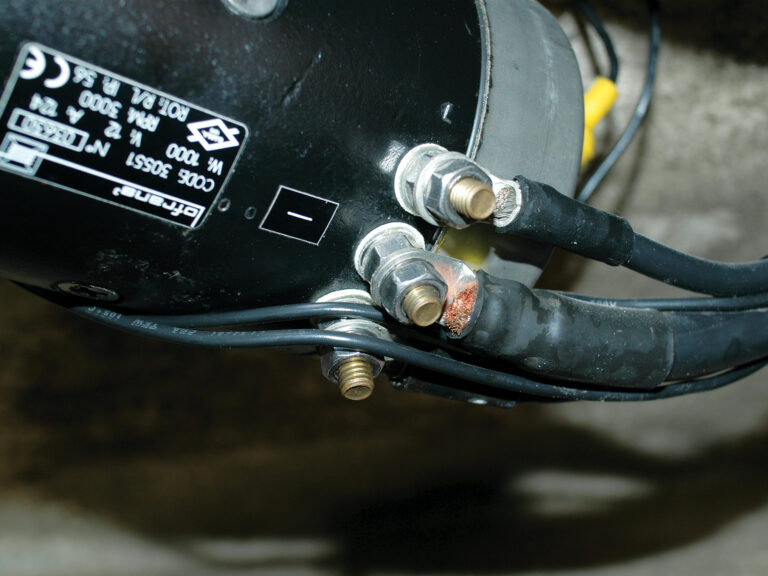
Musto’s MPX Impact is Made for Offshore
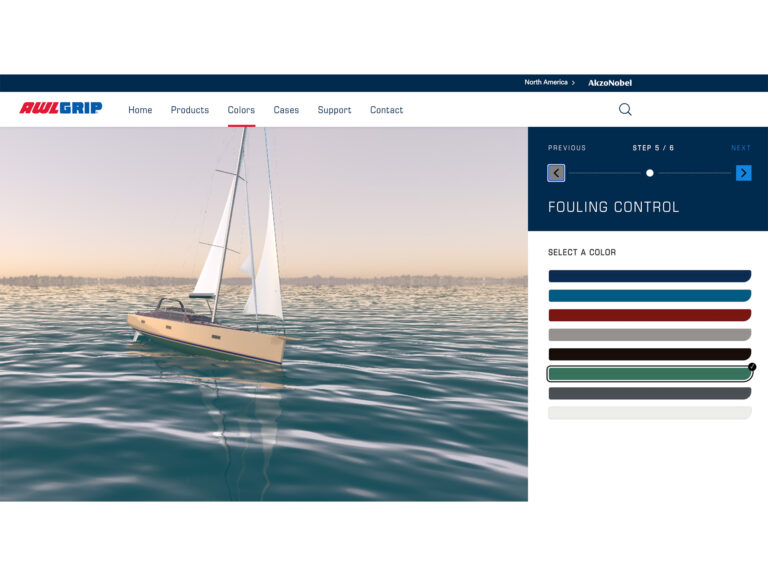
Awlgrip Unveils 3D Color Visualizer
- Digital Edition
- Customer Service
- Privacy Policy
- Email Newsletters
- Cruising World
- Sailing World
- Salt Water Sportsman
- Sport Fishing
- Wakeboarding
A guide to foiling
A hydro-foil is a lifting surface that operates in water and the GC32 is fitted with four of them. The foils are attached to each of the two hulls, the J-foil in the centre and the T-foil on the stern.
The drag caused by the boat’s hulls moving through water is far greater than the drag caused by the hulls moving through air, therefore, due to the decreased drag, a boat in foiling mode can reach higher speeds than a boat in displacement mode.
The GC32 can reach top speeds of around 39 knots (45mph) in foiling mode.
The primary purpose of the J-foil is to create lift. This lift elevates the hulls out of the water as well as counteracting the side force generated by the sails. The ‘J’ shape of the foil makes it a self-levelling foil, which prevents the boat from stalling (dropping back down to displacement mode) once it starts foiling.
What does ‘displacement mode’ mean? When the boat’s hulls are in the water this is known as displacement mode – so called because the hulls are displacing the water.
What does ‘self-levelling’ mean? As the J-foil creates lift the tip of the ‘J’ progressively lifts out of the water and reduces the lift being produced. The J-foil naturally finds the optimum elevation, with the right amount of foil out of the water. Without this feature the foil would continue to produce lift until the bottom of the foil reached the surface of the water, at which point the boat would ‘stall’ and drop back down onto the hulls.
Operated by the sailors using a pulley system, the J-foils have two planes of movement – forwards/backwards and up/down.
Only the leeward J-foil is used to lift the boat out of the water while the windward foil is retracted.
The primary purpose of the T-foil, which is fitted to the rudder, is to balance the lift produced by the J-foil and stop the boat from tipping over. The rudders are longer than those on a displacement boat so that the helm can still steer even when the boat is foiling over a metre in the air. Both rudders are connected, which means that they move in unison no matter which side of the boat the helm steers from.
The same principles that enable an aeroplane to get airborne using its wings allow the GC32 to ‘fly’ above the water on its foils.
The shape of the foil means that water travels faster over the top surface than the bottom. Physics dictates that the faster velocity over the top of the foil also means lower pressure. With higher pressure on the bottom surface of the foil an upward force is produced, which in turn lifts the boat’s hulls out of the water.
The J-foil is like the wing of an aeroplane, producing almost all of the lift, while the T-foil is like the tailplane of an aeroplane, balancing the lift from the wing.
For the GC32 to foil it typically requires over eight knots of true wind speed and over 12 knots of boat speed downwind.
Find out more about the Series
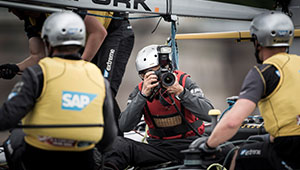
Yachting World
- Digital Edition

Foiling: the history of the hydrofoiler
- Matthew Sheahan
- December 9, 2021
Foiling has taken the watersports world by storm in recent years, but the history of the hydrofoiler goes back further than you might think

The biggest revolution to hit watersports in general has been foiling , and it’s easy to view the use of hydrofoils as a relatively recent phenomenon.
In truth, although foiling has really taken off (if you’ll forgive the pun) in recent years in everything from surfing to sailing, paddleboarding , and beyond, the history of the hydrofoil goes back far further than many might assume.
The world of powered foilers kicked things off early but even sail-powered foiling craft are much older than you may realise.
The history of foiling
The early development of hydrofoils started over 100 years ago when Italian Enrico Forlanini achieved 36.9 knots with his 60hp airscrew-driven boat in 1906. Several engineers took notice, among them the Wright Brothers and Alexander Graham Bell, both of whom experimented with foilborne craft.
Within a few years speeds moved briskly into the 50-knot range for power boats, but it wasn’t until 1938 that a sailing boat got up onto foils with Americans Gilruth and Carl who managed to foil at five knots. Here are some key moments:
1869 – First patent for hydrofoil was for a rowing boat, French application made by Emmanuel Denis Fargot.

First hydrofoil boat built by Enrico Forlanini
1906 – First hydrofoil boat designed and built by Enrico Forlanini. It had a ladder-type construction with multiple struts supporting multiple wings. It achieved 36.9 knots.

Alexander Graham Bell’s HD-4
1918 – Alexander Graham Bell and Casey Baldwin launched their HD-4, a five-tonne vessel powered by two liberty aircraft engines of 350hp each and reached 52 knots. The HD-4 Hydrodrome later set a new world record of 61.58 knots.
1938 – First known sailing hydrofoil was produced by Americans R. Gilruth and Bill Carl.

Gordon Baker’s Monitor
1955 – Monitor clocked at 25 knots. She was designed by Gordon Baker and built by the Baker Manufacturing Company of Evansville, Wisconsin. The US Navy shared part of the cost of construction.
In October 1956 she was recorded at 30.4 knots and was later said to have sailed close to 40 knots.

David Kelper’s Williwaw
1970 – The first hydrofoil cruiser. David Keiper’s Williwaw cruised throughout the South Pacific clocking up 20,000 miles.
1974 – Mayfly foiling cat established world record for A Class in Weymouth at 19.38 knots. In 1977 she set the bar higher at 23 knots.

Icarus, a modified foiling Tornado Photo: Claude Breton
1976 – Icarus , a modified foiling Tornado (above), set a new world record in B class at 20.70 knots. By 1985 Grogono and Fowler had raised their speed to 28.14 knots.

Offshore foiler Paul Ricard
1980 – Eric Tabarly beat the schooner Atlantic ’s transatlantic record by more than two days in offshore foiler Paul-Ricard .
1990 – Hobie Trifoiler, a twin-sail trimaran with a mainsail on each outrigger, capable of 30 knots, making it the fastest production sailboat in the world. The prototype, Longshot , was developed by Dan and Greg Ketterman with Russell Long.
1992 – Russell Long broke his own world records for the fourth time in the Trifoiler clocking 43.55 knots.
1994 – Alain Thébault’s L’Hydroptère foiling tri launched.
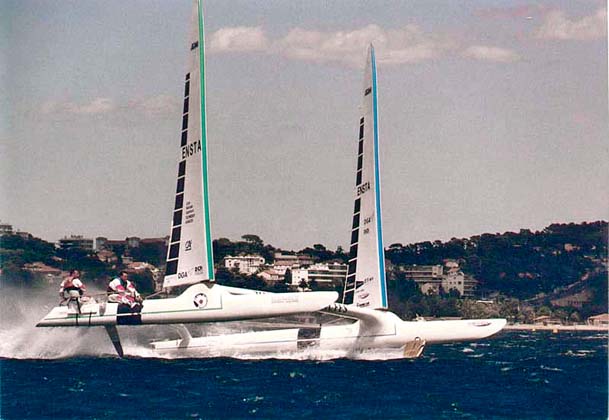
Techniques Avancées, a foilborne proa
1997 – Techniques Avancées , a French foilborne proa, set a new world speed record in the D class, at 42.12 knots
2005 – Rohan Veal wins the International Moth World Championship sailing a Moth class dinghy with hydrofoils fitted.

L’Hydroptère, former speed record holder. Photo: Christophe Launay
2009 – L’Hydroptère set new outright world speed record over 500m 51.36knots.

SailRocket2 clocked an unprecedented 64.45 knots
2012 – Sailrocket II broke L’Hydroptère ’s record to set new outright world record over 500m of 65.45knots.
2013 – The America’s Cup goes foiling as Oracle Team USA beat Emirates Team New Zealand both sailing foiling 72ft catamarans, the AC72s.

The G4 foiling catamaran
2015 – Gunboat launch the Gunboat G4, a foiling high performance cruising catamaran

IMOCA 60 Banque Populaire VIII, sailed by Armel Le Cléac’h wins the 2016/2017 Vendee Globe on a semi-foiling design
2016 – The Vendée Globe sees semi-foiling IMOCA 60 keelboats on the startline for the first time.
2017 – Emirates Team New Zealand win the America’s Cup in a foiling AC50 catamaran

Emirates Team New Zealand racing in the 2021 America’s Cup in Auckland, New Zealand. Photo: ACE / Studio Borlenghi
2021 – Emirates Team New Zealand defend the 2021 America’s Cup in a brand new foiling monohull, the AC75
If you enjoyed this….
Yachting World is the world’s leading magazine for bluewater cruisers and offshore sailors. Every month we have inspirational adventures and practical features to help you realise your sailing dreams. Build your knowledge with a subscription delivered to your door. See our latest offers and save at least 30% off the cover price.
- 2024 BOAT BUYERS GUIDE
- Email Newsletters
- Boat of the Year
- 2024 Freshwater Boat and Gear Buyers Guide
- 2024 Boat Buyers Guide
- 2024 Water Sports Boat Buyers Guide
- 2024 Pontoon Boat Buyers Guide
- Cruising Boats
- Pontoon Boats
- Fishing Boats
- Personal Watercraft
- Water Sports
- Boat Walkthroughs
- What To Look For
- Watersports Favorites Spring 2022
- Boating Lab
- Boating Safety

Foiling Tips and Tricks
- By Morgan Burchell
- February 22, 2023
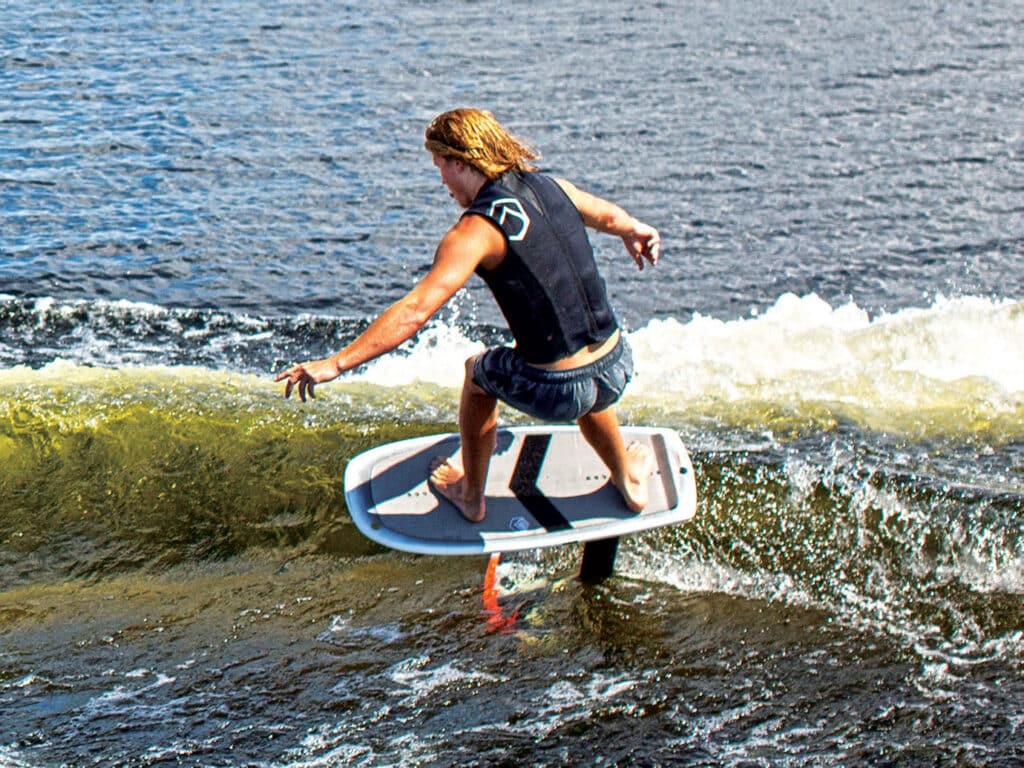
The last few years have lent themselves to plenty of changes and advancements in the watersports world, but one that has seemed to grip these athletes by storm is foiling.
Most people probably remember the good ol’ Sky Skis (or “air chairs”), and the concept is similar. However, instead of a wing attached to a slalom ski with a chair you strap into, the wing is part of what appears to be a type of wakesurf board.
I say “appears to be” because you cannot simply take any board, attach a wing to it and make it work as a foil. In fact, you’d be hard-pressed to find a watersport where the technicality of the equipment itself can make or break your success like it can in foiling. “Once you get the hang of it, though, it truly creates this incredible sense of feeling limitless out on the water,” says Clark Barrineau, a salesman at Boat Town in Texas.
Why? Because you can go anywhere , unlike wakesurfing, where you’re limited to the sweet spot behind the boat, or even wakeboarding , where your momentum disappears without the rope connecting you to the boat. When you ride a foil—and you’re able to pump out of the wave and across the water—suddenly, the entire lake becomes your playground. Ride back to the second, third, even fourth roller behind your own boat. Go steal a wave or back roller from another boat. Go say hi to friends who are taking a break, floating a couple hundred yards away from you. You suddenly have full, complete freedom over where you go out on the lake.
Well, assuming you have the skillset to get there.
There’s definitely a learning curve because the tiniest adjustments in placement, wing size, board type, boat driver and speed, rope length and more have an effect on the rider’s success, which is different than what most of us watersports enthusiasts are used to. Once you can ride a wakeboard comfortably, for example, you can most likely strap into any board and at least get up, ride around and have a good time. On a foil, however, you’ll quickly notice how big of a difference those tiny adjustments can make in your success. Not only do you have forward versus backward movements and heel versus toe weight changes, but now all of a sudden you also have up and down to think about. To add an extra layer to the foiling challenge, it also requires opposite muscle memories and movements from what wakesurfers are used to, providing that extra little fun element in the foil learning process.
Related: Sailing World Expeditions is the go-to place for sailing adventures that fit your on-water lifestyle .
If you’ve never tried foiling before, here’s some advice: Start slow, make the smallest movements and weight adjustments possible, and think the opposite of wakesurfing. I tried it for the first time on a mid-size wing placed at the very back of the board. This allowed for most of my weight to keep the nose of the board down more naturally as I learned to fly up on the wing.
“Your goal, the first time you ride, should be to keep that board as flat on the surface of the water as you can, and gradually let yourself ride higher out of the water as you get balanced,” says Jack Guenther, who served as my awesome coach. This mindset helps gradually ease you, the rider, into that third dimension of up and down out of the water, without suddenly throwing you up and off the board.
Once you can master these movements, the entire lake is your playground.
- More: How-To , March 2023 , water sports , watersports
More How To

Boaters Expect More Hurricanes in 2024
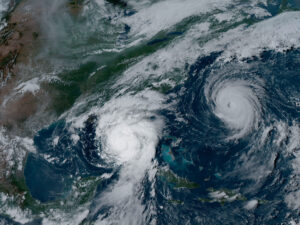
U.S. Hurricane Names Selected for 2024

After a Devastating Loss, One Family’s Resilience Leads to a Lifesaving Rescue
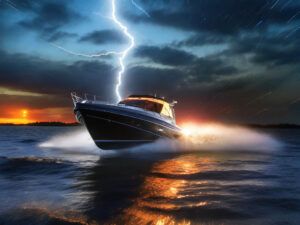
How to Avoid Lightning Strikes While Boating

On Board With: Alexa Score
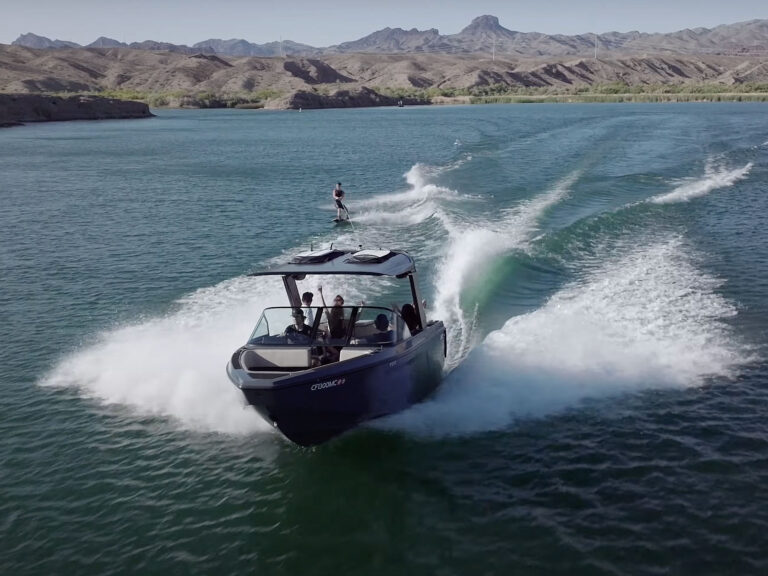
Arc Boats Optimizes Electric Power

- Digital Edition
- Customer Service
- Privacy Policy
- Cruising World
- Sailing World
- Salt Water Sportsman
- Sport Fishing
- Wakeboarding
Many products featured on this site were editorially chosen. Boating may receive financial compensation for products purchased through this site.
Copyright © 2024 Boating Firecrown . All rights reserved. Reproduction in whole or in part without permission is prohibited.
F1x A-class foiling catamaran
World champion, lighter = better, craftsmanship, meet the foiling f1x a-class catamaran.
This is the ultimate singlehanded foiling catamaran of the moment: ultramodern, incredibly fast, very agile, extremely strong and feather-light, in an aerodynamic and ergonomic design. The perfect total package, packed in 1 foiling catamaran. This is the world’s coolest boat for singlehanded races and the winner of several A-cat world championships and many other sailing races.
The 2020-F1x A-cat is exactly the same foiling catamaran that made Mischa Heemskerk Vice-World Champion at the Herveybay Worlds 2018 in Australia and World Champion at Weymouth 2019. All our foiling F1x A-class catamarans come straight, ready to race and ‘Mischa-tuned’ from our factory.
Unique design enables top performances
The F1x A-class foiling catamaran is the ultimate reflection of our current design language. The aerodynamic design accentuates the performance qualities of this super fast foiling racing boat. The sophisticated deck plan provides clear control and minimal air resistance.
Foils The rudders and daggerboard foils used on the F1x A-class foiling catamarans are produced with the highest quality carbon pre-preg fibers. The foils are cured in our own Autoclave . Our winning foil design was created in close cooperation with Glenn Ashby and the designers of AC Team New Zealand .
Construction The F1x A-cat is manufactured entirely according to the carbon pre-preg/ Nomex production method, and cured in our Autoclave. This technology is the same as used in the aerospace industry and within other foiling boats like for example, the America’s Cup.
Design The design of the F1x foiling A-class catamaran was completely conceived by the DNA design team and made at DNA’s own yard. In the DNA design team Pieterjan Dwarshuis, Mischa Heemskerk and the renowned Dutch industrial design engineer Rudo Enserink worked closely together to create the perfect foiling A-class catamaran.
We build your new foiling boat!
Technical details.
The F1x A-class foiling catamaran has a number of unique features that improve performance. For example:
- Semi ridged trampoline. Gives extra torsional stiffness to the boat and increases its aerodynamic characteristics.
- Patented main-sheet-wheel-system. For more direct and faster trim of the main sail.
- Aerodynamically placed traveller car.
- Flexible daggerboard casings. For minimal water absorption in floating mode.
- Aerodynamically shaped ‘beams’.
- Adjustable T-rudders. Foiling with rudder differential is possible.
Specifications
LOA: 5.49 m BOA: 2.30 m Max. draught: 1.20 m Sail area: 13.94 m Total weight: ca. 53 kg Top speed: 31 kn Extra: All measurements according to IACA Class regulations.
Buy a champion's boat!
Are you excited to buy a F1x A-class foiling catamaran from DNA Performance Sailing? Please fill in our contact form:
Yes, I want a F1x A-cat!
Schrijf je in voor onze nieuwsbrief en blijf op de hoogte van de nieuwste ontwikkelingen.
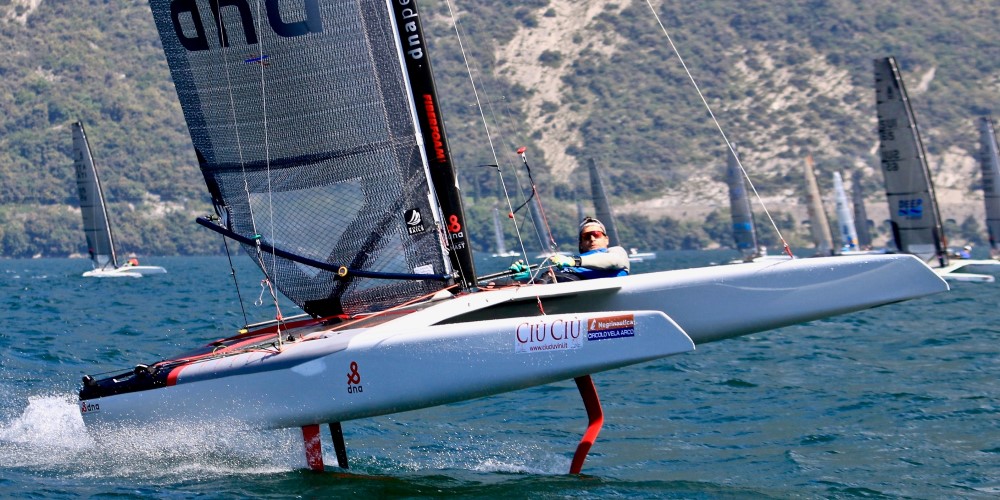
Contactformulier
- Company Name
- Full name * First Last
- Emailaddress *
- Phonenumber *
- Mijn vraag betreft * My question: TF10 F1x G4 F4 Custom Parts Hydrofoils Other
- Email This field is for validation purposes and should be left unchanged.
Registrieren Sie sich für unseren Newsletter
lassen Sie sich über die neuesten Entwicklungen informieren!
- E-Mail-Adresse *
- Comments This field is for validation purposes and should be left unchanged.
Schrijf je in voor onze nieuwsbrief
blijf op de hoogte van de nieuwste ontwikkelingen!
- First name *
- Last name *
- Phone This field is for validation purposes and should be left unchanged.
Wij gebruiken cookies om u de beste online ervaring te bieden. Door akkoord te gaan, accepteert u het gebruik van cookies in overeenstemming met ons cookiebeleid.
Wanneer u een website bezoekt, kan deze informatie in uw browser opslaan of ophalen, meestal in de vorm van cookies. Beheer hier uw persoonlijke cookiediensten.
- wordpress_test_cookie
- wordpress_logged_in_
- wordpress_sec

Support our hydrofoil educational content for free when you purchase through links on our site. Learn more
[2023] Hydrofoil Catamaran: The Ultimate Guide to Foiling on Water
- November 1, 2023
- Hydrofoil Basics
Experience the thrill of flying above the water with a hydrofoil catamaran!
Are you ready to take your hydrofoil boarding to the next level? Look no further than the hydrofoil catamaran. In this comprehensive guide, we’ll dive deep into the world of hydrofoil catamarans, exploring their history, how they work, their benefits and drawbacks, and everything else you need to know to make an informed decision. So, buckle up and get ready to soar above the waves!
Table of Contents
Quick answer, quick tips and facts, how does a hydrofoil catamaran work, benefits of hydrofoil catamarans, drawbacks of hydrofoil catamarans, choosing the right hydrofoil catamaran, maintenance and care, recommended links, reference links.
A hydrofoil catamaran is a type of watercraft that combines the stability of a catamaran with the lift and speed of hydrofoils. It uses specially designed foils to lift the hulls out of the water, reducing drag and allowing for faster and smoother sailing. Hydrofoil catamarans are popular among sailors and water sports enthusiasts for their incredible speed, maneuverability, and thrilling foiling experience.
Shopping Links: Hydrofoil Catamarans on Amazon | Hydrofoil Catamarans on Walmart | Hydrofoil Catamarans on Etsy
- Hydrofoil catamarans can reach speeds of up to 40 knots (46 mph) or more, depending on the design and conditions.
- The foils on a hydrofoil catamaran can lift the hulls out of the water, reducing drag and allowing for a smoother and faster ride.
- Hydrofoil catamarans are used for various purposes, including racing, recreational sailing, and even transportation.
- Foiling on a hydrofoil catamaran requires some skill and practice, but it’s an exhilarating experience once you get the hang of it.
- Hydrofoil catamarans come in different sizes and designs, catering to different skill levels and preferences.
Hydrofoil catamarans have a fascinating history that dates back to the early 20th century. The concept of using hydrofoils to lift boats out of the water and reduce drag was first explored by Italian engineer Enrico Forlanini in the late 1800s. However, it wasn’t until the 1950s that hydrofoil technology started to gain traction in the boating world.
The first hydrofoil catamaran, known as the “Aquavion,” was developed by the French engineer René Guilbaud in the 1950s. This innovative design combined the stability of a catamaran with the lift of hydrofoils, revolutionizing the world of sailing. Since then, hydrofoil catamarans have evolved and become more advanced, offering incredible speed, maneuverability, and stability on the water.
A hydrofoil catamaran works by utilizing hydrofoils, which are wing-like structures mounted underneath the hulls of the boat. These foils generate lift as the boat gains speed, lifting the hulls out of the water and reducing drag. This lift allows the hydrofoil catamaran to achieve higher speeds and a smoother ride compared to traditional boats.
The hydrofoils on a catamaran are typically designed with a curved shape, similar to an airplane wing. This shape creates a pressure difference between the upper and lower surfaces of the foil, generating lift. The foils are usually adjustable, allowing the sailor to fine-tune the performance of the catamaran based on the sailing conditions.
To control the hydrofoil catamaran, sailors use a combination of steering and sail trim. By adjusting the angle of the foils and the sails, they can optimize the lift and balance of the boat, ensuring a stable and efficient ride. It takes some practice to master the art of foiling on a hydrofoil catamaran, but the rewards are well worth the effort.
Hydrofoil catamarans offer a range of benefits that make them a popular choice among sailors and water sports enthusiasts. Here are some of the key advantages of hydrofoil catamarans:
Speed : Hydrofoil catamarans are known for their incredible speed. By lifting the hulls out of the water, hydrofoils reduce drag and allow the boat to glide smoothly above the waves. This enables hydrofoil catamarans to reach impressive speeds, making them a thrilling choice for racing and high-performance sailing.
Maneuverability : The lift generated by hydrofoils enhances the maneuverability of catamarans. With reduced drag, hydrofoil catamarans can make sharp turns and quick maneuvers with ease. This agility is particularly useful in racing scenarios, where every second counts.
Stability : The dual-hull design of catamarans provides inherent stability, even at high speeds. When combined with hydrofoils, the stability of hydrofoil catamarans is further enhanced. This stability makes them suitable for sailors of all skill levels, from beginners to experienced professionals.
Efficiency : Hydrofoil catamarans are more efficient than traditional boats. By reducing drag, hydrofoils allow the boat to sail faster while using less power. This increased efficiency translates to longer sailing distances and reduced fuel consumption, making hydrofoil catamarans an environmentally friendly choice.
Versatility : Hydrofoil catamarans are versatile watercraft that can be used for various purposes. Whether you’re looking for a high-performance racing catamaran or a recreational sailboat for family outings, there’s a hydrofoil catamaran to suit your needs. Some models even offer the option to switch between foiling and non-foiling modes, providing flexibility on the water.
While hydrofoil catamarans offer numerous benefits, it’s important to consider their drawbacks as well. Here are a few potential downsides to keep in mind:
Cost : Hydrofoil catamarans tend to be more expensive than traditional boats. The advanced technology and materials used in their construction contribute to the higher price tag. Additionally, maintenance and repairs can also be costly, especially if specialized parts or services are required.
Learning Curve : Foiling on a hydrofoil catamaran requires some skill and practice. It can take time to learn how to control the boat effectively and maintain stability while flying above the water. Beginners may find the learning curve steep, but with dedication and proper instruction, anyone can master the art of hydrofoil catamaran sailing.
Weather Conditions : Hydrofoil catamarans are sensitive to weather conditions. While they excel in flat water and moderate winds, rough seas and strong gusts can pose challenges. It’s important to be aware of the weather forecast and choose suitable sailing conditions to ensure a safe and enjoyable experience.
Transportation and Storage : Hydrofoil catamarans can be larger and bulkier than traditional boats, making transportation and storage more challenging. Specialized trailers or racks may be required to transport the catamaran, and adequate storage space is needed to protect it when not in use.
Despite these drawbacks, the thrill and excitement of foiling on a hydrofoil catamaran outweigh the challenges for many sailing enthusiasts.
When it comes to choosing the right hydrofoil catamaran, there are several factors to consider. Here are some key points to keep in mind:
Skill Level : Consider your skill level and experience as a sailor. Some hydrofoil catamarans are designed for advanced sailors, while others are more beginner-friendly. Choose a catamaran that matches your skill level to ensure a safe and enjoyable sailing experience.
Intended Use : Determine how you plan to use the hydrofoil catamaran. Are you looking for a racing catamaran, a recreational sailboat, or something in between? Different models offer varying features and performance characteristics, so it’s essential to choose a catamaran that aligns with your intended use.
Budget : Set a budget for your hydrofoil catamaran purchase. Prices can vary significantly depending on the brand, model, and features. Consider both the upfront cost and the long-term maintenance expenses when determining your budget.
Brand and Reputation : Research different brands and their reputation in the hydrofoil catamaran industry. Look for brands with a track record of producing high-quality, reliable catamarans. Reading customer reviews and seeking recommendations from experienced sailors can also provide valuable insights.
Demo and Test Sails : Whenever possible, try out different hydrofoil catamarans before making a final decision. Many manufacturers and dealers offer demo and test sails, allowing you to experience the performance and handling of the catamaran firsthand. This hands-on experience can help you make an informed choice.
Remember, choosing the right hydrofoil catamaran is a personal decision that depends on your individual preferences and needs. Take your time, do your research, and consult with experts to find the perfect catamaran for your hydrofoil adventures.
Proper maintenance and care are essential to keep your hydrofoil catamaran in top shape and ensure its longevity. Here are some maintenance tips to help you keep your catamaran performing at its best:
Rinse with Fresh Water : After each sailing session, rinse your hydrofoil catamaran with fresh water to remove salt and debris. Pay special attention to the foils, as saltwater can cause corrosion over time.
Inspect for Damage : Regularly inspect your catamaran for any signs of damage or wear. Check the foils, hulls, rigging, and sails for any cracks, dents, or loose fittings. Address any issues promptly to prevent further damage.
Store Properly : When not in use, store your hydrofoil catamaran in a dry and secure location. If possible, keep it covered to protect it from the elements. Consider using a boat cover or storing it in a boat shed or garage.
Follow Manufacturer’s Guidelines : Follow the manufacturer’s guidelines for maintenance and care. Each catamaran may have specific recommendations for cleaning, lubrication, and other maintenance tasks. Adhering to these guidelines will help prolong the life of your catamaran.
Seek Professional Assistance : If you’re unsure about any maintenance tasks or need assistance, don’t hesitate to seek professional help. Local boatyards, sailing clubs, or authorized dealers can provide expert advice and services to keep your catamaran in optimal condition.
By following these maintenance tips and caring for your hydrofoil catamaran, you can enjoy many years of thrilling foiling adventures on the water.
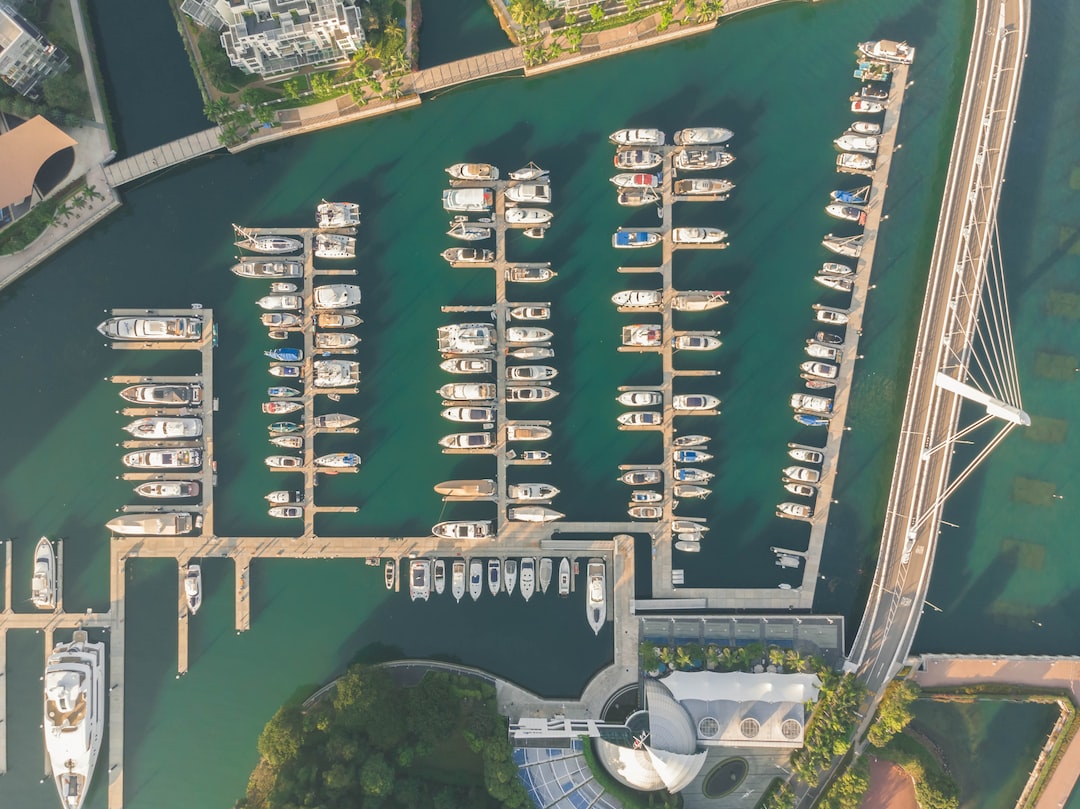
How fast is the hydrofoil catamaran?
Hydrofoil catamarans can reach impressive speeds, depending on various factors such as the design, wind conditions, and skill of the sailor. Some high-performance hydrofoil catamarans can exceed 40 knots (46 mph) or more. However, the exact speed will vary based on these factors.
How does a foil catamaran work?
A foil catamaran, also known as a hydrofoil catamaran, works by utilizing hydrofoils to lift the hulls out of the water. These foils generate lift as the boat gains speed, reducing drag and allowing for faster and smoother sailing. The lift created by the foils enables the catamaran to “fly” above the water, resulting in increased speed and improved performance.
What happened to hydrofoils?
Hydrofoils have a rich history and have been used in various applications, including passenger ferries, military vessels, and recreational boats. While hydrofoils experienced a surge in popularity in the mid-20th century, their use declined in some sectors due to factors such as high costs, maintenance challenges, and the development of alternative technologies. However, hydrofoils continue to be used in niche markets, including high-performance sailing and racing.
Read more about “… What is the World’s Largest Hydrofoil Boat?”
Are hydrofoil boats more efficient?
Yes, hydrofoil boats are generally more efficient than traditional boats. By lifting the hulls out of the water, hydrofoils reduce drag and allow the boat to sail faster while using less power. This increased efficiency translates to longer sailing distances and reduced fuel consumption. However, it’s important to note that the efficiency gains may vary depending on factors such as the design, sailing conditions, and skill of the sailor.
Hydrofoil catamarans offer an exhilarating and thrilling experience on the water. With their incredible speed, maneuverability, and stability, they have become a favorite among sailors and water sports enthusiasts. While they may come with a higher price tag and require some skill to master, the rewards of foiling on a hydrofoil catamaran are well worth it.
When choosing a hydrofoil catamaran, consider factors such as your skill level, intended use, budget, and the reputation of the brand. Take the time to research and test different models to find the perfect catamaran for your needs.
So, are you ready to take flight on a hydrofoil catamaran? Embrace the thrill, experience the freedom, and enjoy the incredible sensation of soaring above the water. Happy foiling!
- Hydrofoil History
- Advanced Hydrofoiling Techniques
- Hydrofoil Equipment Reviews
- Why do boats not use hydrofoils?
- iFLY15 – iFLY Razzor Pro – Foiling Catamaran
- Hydrofoil Catamarans on Amazon
- Hydrofoil Catamarans on Walmart
- Hydrofoil Catamarans on Etsy
Review Team
The Popular Brands Review Team is a collective of seasoned professionals boasting an extensive and varied portfolio in the field of product evaluation. Composed of experts with specialties across a myriad of industries, the team’s collective experience spans across numerous decades, allowing them a unique depth and breadth of understanding when it comes to reviewing different brands and products.
Leaders in their respective fields, the team's expertise ranges from technology and electronics to fashion, luxury goods, outdoor and sports equipment, and even food and beverages. Their years of dedication and acute understanding of their sectors have given them an uncanny ability to discern the most subtle nuances of product design, functionality, and overall quality.
Related Posts
What does foiling feel like [2024] ✨.
- May 15, 2024
How do you ride a hydrofoil? [2024] 🏄♂️
Hydrofoil buyer’s guide: everything you need to know [2024] 🌊.
- May 12, 2024
Leave a Reply Cancel Reply
Your email address will not be published. Required fields are marked *
Add Comment *
Save my name, email, and website in this browser for the next time I comment.
Post Comment
Trending now


What is a Foiling Catamaran? (All You Need To Know)

Have you ever seen a boat literally fly over the water? With a foiling catamaran, that’s exactly what you get.
Foiling catamarans are the latest innovation in sailing technology, making them more efficient, agile, and environmentally-friendly.
In this article, we’ll look at what foiling catamarans are, the benefits they offer, the different types available, their applications, maintenance and care tips, cost, and where you can find them.
So, let’s dive in and learn all about foiling catamarans!
Table of Contents
Short Answer
A foiling catamaran is a type of boat that uses hydrofoils to lift the hulls out of the water, allowing it to sail faster and smoother than a traditional catamaran.
The hydrofoils, which are mounted on the underside of the boat, help to reduce drag and increase lift, allowing it to reach speeds of up to 40 knots (75 km/h).
Foiling catamarans are typically used in sailing races and can be seen in events such as the America’s Cup and the Olympics.
What are Foiling Catamarans?
Foiling catamarans are a type of sailboat that use hydrofoils to lift the hull out of the water at high speeds, allowing for increased speed and maneuverability.
This is achieved by the hydrofoils, which are located on the bottom of the boat and act as wings to create lift and reduce drag.
This type of sailboat has become increasingly popular in competitive sailing, as it is faster and more efficient than traditional sailing vessels.
Additionally, foiling catamarans are used for recreational sailing, making them a great choice for sailors of all levels.
Foiling catamarans are typically constructed from lightweight materials such as carbon fiber or Kevlar, allowing them to be faster and more agile than their heavier counterparts.
They are also equipped with specialized hydrofoils, which are designed to optimize the lift and reduce drag, resulting in faster speeds and better maneuverability.
These hydrofoils are usually adjustable, allowing for further optimization of the boats performance.
Foiling catamarans are typically larger than traditional sailboats, and can be up to 50 feet in length.
They are also typically equipped with multiple sails, allowing for greater control over the boat’s speed and direction.
In addition to their superior performance, foiling catamarans are also more stable than traditional sailboats, making them a great choice for recreational sailing.
Overall, foiling catamarans offer a great combination of speed, maneuverability, and stability, making them a great choice for both competitive and recreational sailing.
Whether youre looking for a competitive edge or just a fun day out on the water, foiling catamarans are sure to provide an enjoyable and thrilling experience.
Benefits of Foiling Catamarans

Foiling catamarans offer many benefits for sailors of all levels.
For competitive sailors, these boats offer superior speed and performance, allowing them to cruise at higher speeds, and with greater maneuverability.
This makes them ideal for racing and other competitive events, where speed and agility are essential.
For recreational sailors, foiling catamarans offer an enjoyable experience that is both safe and exciting.
These boats are designed to be lightweight and stable, making them easy to maneuver and handle.
Additionally, their design allows them to be sailed in a variety of conditions, from light winds to heavy seas.
Lastly, foiling catamarans are environmentally friendly.
As they use hydrofoils to lift the hull out of the water, they reduce drag and produce less wake than traditional vessels.
This means that they have a lower environmental impact, as they use less energy and produce fewer emissions.
Overall, foiling catamarans offer something for everyone.
Whether you are a competitive sailor looking for a fast and agile vessel, or a recreational sailor looking for a safe and enjoyable experience, foiling catamarans provide a great option for all types of sailors.
Types of Foiling Catamarans
Foiling catamarans come in a variety of shapes and sizes.
In general, they are characterized by their use of hydrofoils to lift the hull out of the water at high speeds.
The most popular type of foiling catamaran is the Moth, which has a single central hull and two foils on the bottom.
This type of catamaran is well-suited for competitive sailing, due to its superior speed and maneuverability.
Other types of foiling catamarans include the Nacra 17, the A-Class, and the Formula 18.
The Nacra 17 is a two-person performance catamaran, while the A-Class and Formula 18 are both one-person boats.
All three of these catamarans use hydrofoils to lift the hull out of the water, and are popular in competitive sailing.
For recreational sailing, foiling catamarans come in a variety of shapes and sizes.
Many of these boats are designed for one or two people, and some are even designed for larger groups.
Foiling catamarans are often used for daysailing, racing, cruising, and leisure sailing.
Some of the most popular recreational foiling catamarans include the Hobie 16, the Hobie Mirage, and the Hobie T2.
All of these boats use hydrofoils to lift the hull out of the water, allowing them to sail faster and more efficiently.
Foiling catamarans are also becoming increasingly popular in the world of yacht racing.
These boats are able to reach incredibly high speeds, making them ideal for competitive sailing.
Many yacht racing teams are now using foiling catamarans, such as the America’s Cup teams.
The America’s Cup is the world’s oldest and most prestigious sailing event, and it has now been dominated by foiling catamarans for the past several years.
In conclusion, foiling catamarans come in a variety of shapes and sizes, and are used for a variety of sailing activities.
They are becoming increasingly popular in competitive sailing, due to their superior speed and maneuverability.
Additionally, they are often used for recreational sailing and are enjoyed by sailors of all levels.
Applications of Foiling Catamarans

Foiling catamarans have become incredibly popular in competitive sailing, thanks to their superior speed and maneuverability.
The use of hydrofoils to lift the hull out of the water at high speeds reduces drag and allows the boat to sail faster and more efficiently.
This has made them a favorite among professional sailors, who have used them to set speed records in the Americas Cup and other international sailing events.
In addition to competitive sailing, foiling catamarans are also becoming increasingly popular for recreational use.
They offer a unique sailing experience, allowing even novice sailors to experience the thrill of high-speed sailing.
The hydrofoils also increase stability and make it easier for the boat to turn on a dime.
This makes them a great choice for sailors who want to explore new areas or practice different sailing maneuvers.
The versatility of foiling catamarans also makes them a good choice for sailing clubs that host events for all levels of sailors.
They can be used by beginners to learn the basics of sailing and by more experienced sailors to practice more complex maneuvers.
Additionally, they can be used for a wide range of activities, such as racing, cruising, and even fishing.
Foiling catamarans are also becoming popular among those who want to use them for longer voyages.
The hydrofoils help to reduce drag and increase fuel efficiency, making them a great option for those who want to travel long distances without having to worry about fuel costs.
Overall, foiling catamarans are an incredibly versatile and enjoyable type of sailboat that can be used for a variety of applications.
Whether youre a competitive sailor looking for a competitive edge or a recreational sailor who just wants to have some fun on the water, foiling catamarans are a great choice.
Maintenance and Care of Foiling Catamarans
When it comes to maintaining and caring for a foiling catamaran, there are a few key points to keep in mind.
First, the foils must be inspected regularly for any damage or wear and tear.
This can be done by inspecting them visually or using a borescope to check for any signs of damage or wear.
Additionally, the foils should be cleaned regularly to ensure they are free from dirt, debris, and algae.
This will help maintain optimal performance and reduce the risk of damage or wear.
When it comes to the hulls of the boat, they should also be inspected regularly for any signs of damage or wear.
This can be done by checking the hulls for cracks, dents, and other signs of damage.
Additionally, the hulls should be cleaned regularly to ensure they are free from dirt, debris, and algae.
This will help maintain the performance of the boat and reduce the risk of damage or wear.
Finally, the rigging and sails of the boat should also be inspected regularly for any signs of damage or wear.
This can be done by checking the sails for tears and other signs of damage and by inspecting the rigging for wear and tear.
Additionally, the rigging should be checked periodically to ensure it is properly tensioned and adjusted.
Overall, caring for and maintaining a foiling catamaran requires regular checking of the foils, hulls, rigging, and sails.
This will help ensure the boat is performing at its best and reduce the risk of damage or wear.
Additionally, regular cleaning of the foils, hulls, and rigging will help maintain the performance of the boat and ensure it is safe to sail.
Cost of Foiling Catamarans

For those looking to get into the sport of sailing, the cost of a foiling catamaran can be a major consideration.
While these boats are superior in terms of speed and maneuverability, they can also be expensive.
The cost of a new foiling catamaran can range from tens of thousands of dollars to several hundred thousand dollars, depending on the size and features of the boat.
Additionally, there are ongoing costs associated with foiling catamarans such as repairs and maintenance, as well as upgrades and accessories.
That said, it is possible to find used foiling catamarans for sale at a fraction of the cost of a new one.
Used boats may not have all the bells and whistles of a new model, but they can still be a great way to enter the world of sailing.
Many used foiling catamarans are also ideal for recreational sailing, and can provide hours of enjoyment.
For those looking for the ultimate sailing experience, a foiling catamaran may be the perfect choice.
The cost of these boats may be high, but the performance and enjoyment they deliver is unmatched.
With the right maintenance and upgrades, a foiling catamaran can provide years of fun and adventure.
Where to Find Foiling Catamarans
Foiling catamarans have become increasingly popular in recreational and competitive sailing, and are now available from a wide variety of retailers.
For those looking to purchase a foiling catamaran, there are a few different options to consider.
For those looking to buy a brand new foiling catamaran, there are several manufacturers that specialize in producing boats of this type.
These manufacturers typically offer a wide range of models, from high-performance racing boats to more relaxed recreational sailing boats.
Additionally, there are also online stores that specialize in selling foiling catamarans, offering a variety of models from different manufacturers.
For those looking for more of a budget-friendly option, there are also a number of used foiling catamarans available on the market.
These boats can often be found at online marketplaces or at sailing clubs and marinas.
Additionally, some sailing clubs and marinas offer rental foiling catamarans, allowing sailors to try out the boats before making a purchase.
Finally, for those who are looking to build their own foiling catamaran, there are a variety of kits and plans available online.
These plans often include detailed instructions, diagrams, and materials lists, making it easier for aspiring boat builders to construct their own boat.
In any case, there are plenty of options for those looking to purchase or build a foiling catamaran.
With the right research and preparation, anyone can enjoy the exhilarating experience of sailing a foiling catamaran.
Final Thoughts
Foiling catamarans are a type of sailboat that offer superior speed and maneuverability, and are becoming increasingly popular in competitive and recreational sailing.
With their various designs, applications, and maintenance requirements, foiling catamarans are perfect for sailors of all levels.
If you’re looking to pick up a foiling catamaran for yourself, be sure to research the different models, their associated costs, and where you can find them.
With the right care and maintenance, you’ll be sure to enjoy your foiling catamaran for years to come!
James Frami
At the age of 15, he and four other friends from his neighborhood constructed their first boat. He has been sailing for almost 30 years and has a wealth of knowledge that he wants to share with others.

Recent Posts
When Was Banana Boat Song Released? (HISTORICAL INSIGHTS)
The "Banana Boat Song" was released in 1956 by Harry Belafonte. This calypso-style song, also known as "Day-O," became a huge hit and remains popular to this day for its catchy tune and upbeat...
How to Make Banana Boat Smoothie King? (DELICIOUS RECIPE REVEALED)
To make a Banana Boat Smoothie King smoothie at home, start by gathering the ingredients: a ripe banana, peanut butter, chocolate protein powder, almond milk, and ice. Blend the banana, a scoop of...

12 foiling boats for sailors of all levels
- April 15, 2022
- No Comments
THE PERFECT GIFT!
Give or treat yourself to a subscription to the print + digital Journal of Sailing and for only 69 euros a year you get the magazine at home plus read it on your PC, smartphone and tablet. With a sea of advantages.

There’s no denying that the phenomenon of the moment, when it comes to having fun, is foiling boats (as Checco Bruni told us himself in this article). In the wake of the latest editions of the America’s Cup, flying boats, especially in the dinghy segment, have become increasingly widespread. On one or two hulls, with one or more foils, more or less easy to fly, single or crewed.
We have selected for you 12 flying boats with which to enter the world of foils or with which to try and perfect your skills. We also tell you how much they cost and the “difficulty of flight” (XXX: difficult; XX: medium; X: easy). The only common denominator is that they are great fun!
Birdyfish – 4,7 m – For foiling beginners
Flying difficulty: X

The ideal boat for learning to sail foils, even for beginners. Very few trim adjustments for foils allow you to enjoy all the excitement and joy of flying. The crew will only have to deal with sail trimming. The appendages with a soft-angled L guarantee take-off from 10 knots of wind. The shape of the bow works well even in waves. Price: 16,980 euros.
FIND OUT MORE
Flo1 – 4.25 m
Flying difficulty: X

An interesting single to approach and perfect in the world of small foilers before moving on to more sophisticated craft. Produced by the Dutch company Aeronamics, it has a soft, almost C-shaped foil. There is no adjustment of the rake of the appendages but only its extension in the water, which makes the “trim” of these appendages easy and intuitive after just a few trips. Top speeds are around 20 knots. Price: 15,495 euros.
DISCOVER MORE
NACRA F20 – 6,20 m – Like America’s Cup cats
Flying difficulty: XXX

The Nacra yard, which specializes in open catamarans and produces the Nacra 17 Olympic class, has fitted its F 20 model with a “Flight Control System” to make it fly. The Nacra 20 FCS was designed by Pete Melvin and Gino Morelli, the authors of the 2013 America’s Cup rulebook, and its foils are reminiscent of those on the AC72 in San Francisco. A very physical boat and not for everyone. Price: 34,000 euro.
Foiling Dinghy – 3,86 m – Small and versatile

It weighs 30 kilos and can be foiled as early as seven knots of wind. The Foiling Dinghy is equipped with an inverted T rudder and a pair of curved foils that act as both lifting and straightening foils, with an automatic management system. The foils have a few simple adjustments depending on what you want to achieve (more flying or more straightening). Price: 15,500 euros including taxes.
Moth – 3,35 m – The foiling cult dinghy

The progenitor of the flying dinghies is still one of the most complete single foilers on the market today. Suitable mainly for advanced sailors who already have experience on foils, it has appendages that offer multiple setting options and the possibility of being changed according to wind strength. The international class is one of the most active and always organizes very crowded races. Cult product. Price: from 20,000 euros.
Peacoq 14 – 4.70 m – Like a flying Fireball
Flying difficulty: XX

With a hull that is vaguely reminiscent of the old Fireballs with a “cut” bow, the Peacoq 14, an evolution of the Club version, is a dinghy that can be a compromise for both novice and experienced foil sailors. In fact, the dinghies can be operated in automatic trim, or more experienced sailors can adjust their angle for maximum performance. Price: quote on request.
Persico 69F – 6,9 m – The trendy boat

This concept boat is the brainchild of the Italian racing elite (Giorgio Benussi, Dede de Luca, “l’oriundo” Maciel Cicchetti) and was designed by Argentineans Wilson and Marquinez. Flying the 69F is not too difficult, although it does require a good physique and strength in the arms, especially for the mainsail trimmer and the foil adjuster. The racing circuit has now been launched with an attractive programme. Price: rented by the season.
Skeeta – 3,35 m – Easy for anyone

Ease first. The idea behind Skeeta is the same as that of many other small foilers: to make this type of wing easy and open to everyone. Skeeta is a single glider that flies on two self-regulating appendages, not particularly technical to fly but still very high performance, with the particular shape of the hull that distinguishes all Quant models. Price: 15,345 euros.
Stunt S9 – 4,16 m – The Italian Foiling cat

This is an all-Italian One Design catamaran that can be sailed as a single with just a mainsail or even a jib depending on the weather conditions. Like other catamarans, to improve stability in flight, it moves on four submerged appendages. Physically it requires a certain amount of athleticism, also because there is a trapeze, but with a little training it can be suitable for a wide audience. Price: 16,600 euros.
Ufo – 3,00 m – Flying with two hulls

This small catamaran is equipped with a sensor that self-adjusts the inclination of the single central foil, coupled to the T of the rudder. It can take off even in light winds thanks to the lightness of its construction. The cat is quite easy to sail, suitable even for sailors who do not have much experience with foils.
The official european dealer for Foiling UFO is Sea-Change . Price: 8.980 euros + VAT
Waszp – 3,35 m – For the whole family

Very similar to the Moth, but with one big difference: the Waszp is a monotype, it is not made of carbon and the appendages being monotyped cannot be changed. For this reason it is less expensive than the Moth, even if it does perform somewhat less well. It is considered by many to be an ideal “family” boat because it is fun for both young and old. The foil adjustment system is managed by a sensor, but it is possible to set the appendages and modify some adjustments. Price: 12,200 euros.
Whisper – 5,40 m – Full performance

As light as the highest performing Cats, it features a one-piece, non-removable platform that provides great structural rigidity. Equipped with the four classic self-adjusting appendages, it is able to set sail in light breezes with a certain ease. It is a double, with trapeze, mainsail, jib and gennaker, fast even in light winds. Physically demanding. Price: 26,900 euros.
HELP US TO KEEP YOU ALWAYS UPDATED
The journalists of Giornale della Vela , together with Motorboats and Top Yacht Design, commit themselves every day to guaranteeing quality, updated and correct information on the world of boating for free through the websites. If you appreciate our work, please support us by subscribing to our magazine. The annual subscription costs only 49 euros!
DISCOVER OUR YOUTUBE CHANNEL
Every day, interviews, sea trials, webinars. All the sailing world, minute by minute, but on line. CLICK HERE to sign up, it’s free!
SUBSCRIBE TO OUR NEWSLETTER, IT’S FREE!
To stay updated on all the news from the world of sailing, selected by our editorial staff, subscribe to the newsletter of Giornale della Vela! It is very simple, just enter your email below, accept the Privacy Policy and click on the “Subscribe” button. This way, you will receive the best sailing news in your email twice a week! It is free and you can unsubscribe at any time, without obligation!
Once you click on the button below, check your mailbox
Accetto la Privacy Policy
Leave a Comment Cancel Reply
Your email address will not be published. Required fields are marked *
This site uses Akismet to reduce spam. Learn how your comment data is processed .
Check out the latest issue

Are you already a subscriber?
- Read your magazine from your pc here! >>
- Renew your subscription >>
- Reset your account password >>
How to have the cabin comfortable all year round by installing an accessory
Seven questions to the desalinator. here’s what to know about this accessory, these folding solar panels can also be mounted on the awning, christening in the waters of trieste for the ecoracer 30, the sustainable boat, ultimi annunci.
Sign up for our Newsletter
We give you a gift

Sailing, its stories, all boats, accessories. Sign up now for our free newsletter and receive the best news selected by the Sailing Newspaper editorial staff each week. Plus we give you one month of GdV digitally on PC, Tablet, Smartphone. Enter your email below, agree to the Privacy Policy and click the “sign me up” button. You will receive a code to activate your month of GdV for free!
You may also be interested in.

Legendary Classic Boats: 5 myths of the 1970s (14 to 40 thousand euros)
To talk about Classic Boats in general sometimes misses the nuances and subtleties that each design phase entailed, as well as its evolutions and philosophies. We selected 300 projects of excellence, 300 models of historical value to celebrate and enhance.

Want to enhance the value of a used boat over 25 years old? Here’s how to do it
Classic Boats of Historical Value now number 300, and will continue to grow. Meanwhile, thanks to the section of our website “ Classic Historic Boats ” you can, however, already find the 300 boats at least 25 years old that

Shamrock V, legendary J-Class, finally returns to sailing.
Sir Thomas Lipton is a name of some note in the sailing world. More specifically, in the world of the America’s Cup. For as many as 31 years he was the “best of losers,” the one who, continuously, from 1899

Classic Boat: 4 new “Classics” between 12 and 13 meters arrive
Classic Boats of Historical Value by Journal of Sailing never stops updating! With this in mind, thanks in part to your suggestions, 19 new boats have arrived, 19 new Classic Boats to be celebrated and enhanced. We have now passed
Sailing Newspaper
Editor-in-Chief: Luca Oriani
TO COMMUNICATE WITH THE EDITORIAL STAFF 02 535 811111 – [email protected]
FOR ADVERTISING Senior account: Guido De Palma: tel. 02 535811208 cell. +39 347 2347433 [email protected].
Pierfrancesco Pugno: cell. +39 3496621980 [email protected]
Cookie policy Privacy policy

INFO SUBSCRIPTIONS, DIRECT SALES AND DIGITAL PRODUCTS
tel. 02 535811 111/200 [email protected]

- Subscribe Now
- Digital Editions

Best hydrofoil boats: 6 of the most spectacular foiling motorboats money can buy
- Electric boats
- Top stories
Foiling technology has really taken off in the past few years. We pick out 6 of the best hydrofoil boats you can buy right now…
With its roots in the 19th century, foiling technology is as old as the hills, but in the past five years we’ve noticed an explosion of hydrofoil boats coming onto the market.
In part inspired by the foiling raceboats of the America’s Cup , the popularity of foiling is easy to understand – fuel efficiency gains are substantial, noise is almost eliminated (particularly if your foiling boat also happens to be an electric boat ) and they look as cool as a snowman in a freezer!
To help you understand the dizzying array of foiling boats available right now, we’ve put together the following guide to what we think are the most promising designs out there.
6 of the best hydrofoil boats

SEAir foiling RIB
Founded in 2016, French yard SEAir builds foiling RIBs, having been inspired by the speed of foiling racing yachts.
We tested their 5.5m model back in 2018 and since then they have expanded their range to cover superyacht chase boats, commercial and military vessels.
Our tester recorded a top speed of 32 knots, with the foils doing their best work at around 20 knots, but SEAir claims that 42 knots is possible in the right conditions.
Read more about the SEAir foiling RIB
Article continues below…
Spirit Yachts launches spectacular long-range electric flying boat
Bmw launches new icon electric boat at cannes film festival.
The Cannes Film Festival has seen the launch of the new ICON electric boat. Created by BMW in collaboration with

A dual helm set-up allows the boat to be piloted from the bow or the cockpit. Photo: Guillaume Plisson
Enata Foiler
Dubai-based Enata Marine added a healthy dose of glamour to the world of foiling boats in 2018 with the launch of its Foiler.
In addition to a superyacht tender-worthy exterior, this 32fter includes a bow window for spectacular views while underway.
A 40-knot top speed and a 190nm range makes this a very appealing option, although the premium price tag of $938,000 may put some off.
Read more about the Enata Foiler

Princess R35
When British boatbuilding giant Princess Yachts got in on the foiling boat game in 2019 with a 35ft carbon-fibre dayboat, we knew that things had really taken off.
While the foil-assisted R35 may not have the spectacular cruising-above-the-waves appeal of some other foiling boats, it is highly efficient, beautifully designed (in collaboration with Pininfarina) and handles like nothing else we’ve ever driven.
In our review, we praised its rare combination of agility, refinement and stability, with spray kept in check impressively at high speeds.
Read more about the Princess R35

The foiling Candela C-8 is the first boat to use Candela’s proprietary C-POD, but bigger craft will follow later
Candela C-8
Swedish firm Candela burst onto the scene in 2021 with its debut, the Candela C-7 , which was billed as the world’s first electric foiling boat, but it was the 2022 launch of the Candela C-8 that really moved the game on.
Available with a 69kWh battery, adapted from the Polestar 2 electric car, owners can expect a range of 57nm at 22 knots, more than enough for dayboat use.
The consumption figures are truly staggering, with Candela’s figures suggesting that the C-8 is more than 12x more efficient than an equivalent 300hp outboard powered sportsboat.
Read more about the Candela C-8

The electric Iguana is capable of three knots on the land and 30 knots at sea
Iguana Foiler
Not content with being at the forefront of the amphibious boats market with its caterpillar-track offering, French yard Iguana has set its sights on the world of foiling too.
Announced last year, the Iguana Foiler will be powered by the world’s most powerful electric outboard engine, the 300hp Evoy Storm .
Having tested both the engine and the boat separately, we can’t wait to see the result when they come together with the added advantages of foiling technology. Watch this space…
Read more about the Iguana Foiler

The foils lift up at slow speeds to reduce the draft
Mantaray M24
Another exciting model in the hydrofoil boats pipeline, this 24ft runabout is particularly interesting is its simplicity. Unlike its main foiling rival, the Candela C-7, the Mantaray M24 requires no complicated electronics to ‘fly’.
Instead it uses the builder’s patented mechanical hydrofoil system, which it has trademarked as Dynamic Wing Technology or DWT. The technology is said to be the result of ten years’ development work and uses a retractable T-foil in the bow and H-foil amidships that self-stabilise mechanically.
This allows it to lean naturally into corners and ride serenely over waves without relying on a network of sensors and algorithms to monitor and adjust the foils. If it proves effective this could drastically reduce the cost and complexity of foiling boats, while simultaneously increasing reliability.
Read more about the Mantaray M24
It doesn’t end here, with fascinating one-off projects from Spirit Yachts and BMW on the water, it’s clear that foiling has a huge potential for transforming the world of boating.
Read more about hydrofoil technology
What we know so far about Enata’s designer foiling motor boat, Vatoz
Cormate chase 32 tour: fast, stylish and practical weekender, axopar 29 sea trial: sun top vs cross cabin – which is best, latest videos, sunseeker ocean 182 – see how this compact superyacht copes in a wet and windy sea trial, delphia 10 boat tour: great value family cruiser.
Foiling 101
The F101 takes you through your foiling journey, providing a progression pathway from the beginner foiler to the Olympian. F101 sets new challenges and goals at whatever level you come in, from expert to beginner.
The F101 is an all-new foiling trimaran aimed specifically at those sailors that, for whatever reason, thought foiling was too difficult for them. The concept originates from the experience of teaching many people to foil in the International Moth class and addressing the main barriers they faced. So we set about creating a new boat without the design restrictions of a box rule – in this way, foiling has been made easier.
“The boats are great fun and I was foiling after about 10 minutes on the first day and having extended periods of foiling after day 2. Not having sailed dinghies for the better part of 20 years, I never really expected to foil, so the boats are fulfilling their designed purpose beautifully. ” — Pete Selby
As an F101 owner, you get access to all of this knowledge and experience, plus access to the F101 Tribe.
The F101 Tribe is an exclusive social media channel that only owners can access, share experiences, tips, and events and generally have a fun time with foiling at the heart of the journey. It is like having a 24/7 help desk..someone, somewhere in the World, is normally awake to help!
The ethos of Foiling World and the F101 TRIBE is to:
· Sail a Fun boat
· Sail with great friends
· Sail in great locations
The F101…more than just a boat! We guarantee to get you foiling, wherever you are in the world, as remote as you like. If you buy an F101, you will FOIL! GUARANTEED!
Whatever your chosen medium, whether it’s a phone, email, text or WhatsApp, we will get back to you!
You can find our phone number and email over on the right-hand side of this page. What are you waiting for?
Few companies give you direct access to this amount of experience, not just before purchasing a boat but throughout your foiling journey.
Got a question? Looking to become an F101 Tribe member? We’d love to hear from you! Contact us .
Electric boats
Electric hydrofoil, meet vessev and its ultra-efficient electric hydrofoil boat designed for smooth tourist rides.
A new all-electric maritime specialist called Vessev has come out of stealth mode with an exciting new vessel called the VS—9. The electric hydrofoil boat offers a state-of-the-art design that delivers incredible efficiency, providing future tourists with a smooth and quiet ride as Vessev looks to commercialize into larger vessels that can transport 100 passengers at a time.
Vessev, formerly known as Seachange, is a young, eco-friendly boat builder founded a few years ago by two bright minds with backgrounds in innovation, including a tenure at Apple. The company was founded in Auckland, New Zealand, where it currently operates and is conducting sea trials of its flagship vessel—an electric hydrofoil boat called the VS—9.
Designed for commercial operations and tourism, this electric hydrofoil “flies” above the water, offering a new futuristic option in sea travel that will soon be used as a passenger ferry thanks to NetZero Maritime – the green technology team at Fullers360 – New Zealand’s largest ferry operator, who has already signed on to help commercialize the hydrofoil technology.
But that’s not all. Vessev may be young, but it has a clear vision for the future of clean maritime transport, and the VS—9 is merely its starting point for larger electric hydrofoil boats and more scaled deployments. Per Vessev co-founder and CEO Eric Laakmann:
We are in the earliest stage of a global transition to sustainable energy use. Our partnership with NetZero Maritime is one of the most powerful in the world in accelerating the adoption of new technologies. There are 33 million vessels in the world today with sustainable vessels representing the smallest fraction. Through significant enhancements in efficiency, hydrofoiling will play a key role in this once-in-a-generation shift.
Vessev’s entry into cleaning up and potentially revolutionizing the maritime segment begins with the VS—9 electric hydrofoil, which has made its public debut and will soon be certified for commercial operations overseas. Have a look.
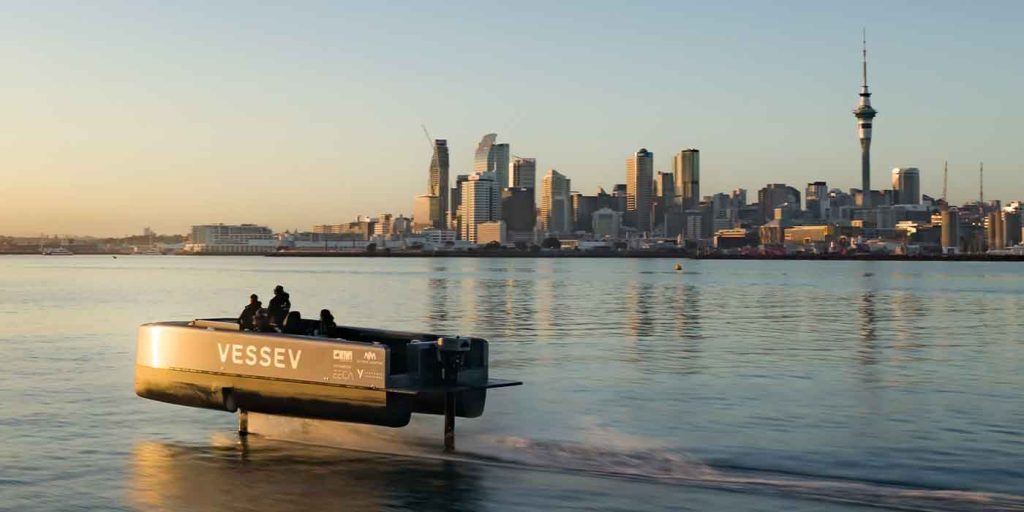
Vessev looks to expand to larger electric hydrofoil boats
The maritime developer shared details of its flagship electric hydrofoil boat this week as it came out of stealth mode with some impressive in-house technology, encouraging performance specs, and a detailed plan for its expansion into commercial ferry operations and beyond.
The VS—9 was designed using the same state-of-the-art foiling technology used in the America’s Cup (the oldest international competition still operating in any sport) to maximize efficiency and range by foiling above the water. Vessev shared that its electric hydrofoil boat technology reduces energy consumption by up to 95%.
This technique not only enables the vessel to travel farther on a charge due to less impact from waves and wake but also delivers a smoother ride for passengers. Add the quietness of an all-electric motor, and you get a new breed of boat that feels like the ideal way to travel across water.
The new electric hydrofoil boat offers room for ten passengers and can travel at a service speed of 25 knots (~29 mph). The VS—9 has a range of 50 nautical miles (57 miles/92.6km) and can recharge its batteries at any marina plug. If that area happens to have a DC fast charger, Vessev says the VS—9 can recoup 0.8 nautical miles of range per minute.
The VS—9 is undergoing sea trials out of Auckland, and its initial tests have been encouraging. Laakman explained:
We use techniques similar to America’s Cup vessels which provide very high control authority when compared to other systems. That means we can handle more wind and bigger seas. The system is more difficult to engineer up-front, but results in a very performant vessel that is both more capable and more efficient. The VS—9 is so efficient that we are able to use very safe and longer-lasting battery technologies when compared to other vessels of this type. To put it into perspective, the VS—9 is undergoing on-water testing with a petrol-powered chase boat following, doing the same motions and distance. At the end of each day, the cost of the petrol fueling the chase boat is 25 times the cost of the electricity used to charge the VS—9.
Vessev is seeking certification later this year, with commercial operations carried out by Fullers360 in New Zealand thereafter. In addition to the ten-passenger VS—9, Vessev shared that it is already working to scale its technology into larger electric hydrofoil boats, including a new 100-passenger vessel called the VS—18. According to the company, that hydrofoil will have “additional seakeeping capability and unlock even more opportunities.”
FTC: We use income earning auto affiliate links. More.


Scooter Doll is a writer, designer and tech enthusiast born in Chicago and based on the West Coast. When he’s not offering the latest tech how tos or insights, he’s probably watching Chicago sports. Please send any tips or suggestions, or dog photos to him at [email protected]

Manage push notifications


Boatsetter’s Summer Travel Trends

Last Updated on May 31, 2024 by Boatsetter Team
Whether you’re planning a visit to a National Park, in search of unique experiences , or in needs of ideas for the Fourth, we hope these travel trends guide you to the best summer yet. The key takeaways that follow are supported by various market trends.
- Approximately 82% of American adults plan to travel during summer, with a significant portion choosing waterside destinations .
- Water skiing, wakeboarding, water foiling , and kayaking are a few of the most preferred water activities by vacationers.
- Since the boom of the Experience Economy in 2019, people are seeking more experiential activities than ever before.
- Alongside the trending concept of “blue spaces,” water-based activities such as swimming, kayaking, and paddling promote calmness, joy, and reduce social anxiety.
Trending destinations for boating & on-the-water experiences
- San Diego, CA
- Miami, FL
- Los Angeles, CA
- Destin, FL
- Panama City Beach, FL
Find unique boat rentals & on the water experiences by destination
Water-based summer activities
From kayaking to swimming, to beach pickle ball or frescobol, water-based activities are among summer’s most preferred, driven by a combination of factors including their appeal across diverse groups, accessibility and affordability, and the promotion of health and fitness.
Visits to National Parks
During summer, many people will be traveling to visit National Parks like Yosemite, Yellowstone, and Rocky Mountain. While there are many wonders to see by foot, many of the National Parks that are best explored by boat .
Summer barbecues
The people have spoken: July is the best month for barbecuing in the US. 55% of people prefer to barbecue in July, versus 51% in June. With many boats including unique features such as grills on board , people can enjoy a summer’s dynamic duo of fun: boating and barbecuing .
Beach days straight ahead
Increased visitation numbers in coastal national parks such as in Florida and California during summer indicate you can expect to see people from coast to coast beach-related activities. Whether in the mood for a secluded beach, a vibey sandbar , or seeing your favorite beach from a new lens, make your next beach day a boat day.
25+ incredible experiences across watery six categories
Boatsetter is introducing the Summer Collection , a curated selection of boating and on-the-water experiences, designed for an epic summer. Go boating with a pro athlete. Book a 60 ft yacht for $1. Or, see natural wonders from a unique perspective.
Choose from six watery categories
- Only by boat – Explore remote destinations only accessible by boat.
- Be a local – Experience destinations with the insights of a local.
- Pop culture – Relive iconic on-screen moments, but on a boat.
- Go fish – Cast a line with local anglers.
- Adventure & spor ts – Go for a thrillride on the water.
- Great outdoors – Discover the best our planet has to offer.
Explore Boatsetter’s Summer Collection
About us
Boatsetter is the leading online marketplace for boat rentals and on-water experiences. Download the Boatsetter app ( App Store | Google Play ) and follow us on Instagram .

Boatsetter empowers people to explore with confidence by showing them a world of possibility on the water. Rent a boat, list your boat, or become a Boatsetter captain today.
Browse by experience

Explore articles
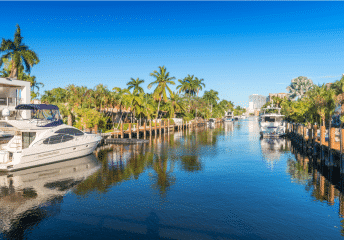
6 Best Restaurants on the Water in Fort Lauderdale to Get to By Boat
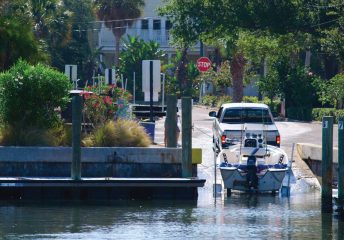
How to Back Up a Boat Trailer in 7 Easy Steps

Share Booking Details: How to Bring Friends Aboard
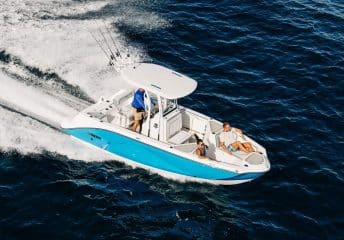
10 Best Luxury Center Console Boats

Fullers, Vessev, launch ‘world’s first electric hydrofoiling tourism vessel’ onto Auckland Harbour
F ullers and boat-making startup Vessev are testing what they call “the world’s first electric hydrofoiling tourism vessel” on Auckland’s Waitematā Harbour.
The VS-9 can hold 10 passengers.
Fullers boss Mike Horne sees it being booked ad-hoc by tourists for a jaunt to Waiheke or a thrill ride around the Harbour- but also as a stepping stone for a larger commuter boat.
Horne says the final fit-out will include a cabin top, a Learjet-like finish in its interior - and be a smooth ride thanks to the hydrofoiling technology designed by Team NZ, Oracle Racing and SailGP alumni.
“You’ll be able to talk on a cellphone or give a presentation at 20 knots, which you can’t on a regular boat,” the Fullers chief executive says. “It’ll be very stable.”
The zero-emission, carbon fibre laminate VS-9 has partial foiling from 12 knots, reducing pitch-and-roll motion and “takes off” to full-foiling mode waves at 18-19 knots.
- No crew, no problem: The NZ Navy’s new uncrewed surface vessel (USV) hits Auckland harbour
- Battery blues delay Auckland’s electric ferries
If the VS-9 gains Maritime NZ certification in time for summer, Horne won’t be ordering another half-dozen 10-seaters.
Rather, he sees the smaller boat as a proof-of-concept. If all goes well, Fullers plans to work with Vessev on a 100-passenger, 19m version.
Horne says that could be hydrogen or electric-powered, and could be serving the Auckland-Gulf Harbour run (that is, on the open seas) within three years. Hydrofoils would not be used by Fullers in the inner harbour, where 200 and 300-person electric ferries are in the works .
The VS-9 was first tested on May 10, and has now been to Waiheke and back 13 times - with Vessev’s engineering whiz founder Max Olson (now the firm’s chief technology officer) taking the wheel as test driver.
$8 power per trip
Each return Auckland CBD-Waiheke trip cost $8 in charging, Vessev chief executive Eric Laakmann told the Herald .
A chase boat, “which was actually lighter” used $140 in petrol for the same trip.
Unlike the big electric ferries on the way next year (which will require $27.5m worth of multi-megawatt chargers ) no new infrastructure is needed.
The VS-9 has been charged from a regular, three-phase 22kW charger at Orams Marine. A 90kW DC charger will give it 8 nautical miles of range per 10 minutes of charging, Laakman says. A portable 40kW charger will be bundled with the final product.
Mix of backers
The VS-9 features the logos of Vessev’s various financial backers.
They include EECA (the Energy Efficiency and Conservation Authority), which has chipped in $1.2 million from the Government’s Low Emission Transport Fund across three grants.
And also equity investors Icehouse Ventures (the largest shareholder, with a 27 per cent stake) and Sir Stephen Tindall’s K1W1, which owns 23 per cent of the company. (Smaller shareholders include Blackbird Ventures, Olson, Shasta Ventures, Port of Auckland and Laakmann.)
The fourth logo on the boat is for NetZero Maritime - the name Fullers gives its in-house clean tech development team. NetZero Maritime has also been reserved as an approved name for a possible future standalone firm.
Laakmaan - an American - was a development lead for the original Apple Watch.
He was in the midst of a sailing-around-the-world sabbatical when pandemic border closures forced an extended stay in Auckland.
There he ended up joining Olson at the firm then known as Seachange. He gained permanent residency last month after submitting an application that included non-standard support material in the form of a video of him on the VS-9, holding a New Zealand flag.

- Share full article
Advertisement
Supported by
From 700 A.D., a Pre-Viking Vessel Rises Into View
On the Norwegian island of Leka, archaeologists have unearthed the earliest known ship burial in Scandinavia.

By Franz Lidz
For hundreds of years, Norwegians thought they knew who or what had been interred in an enormous barrow on the island of Leka, which is just off the country’s northern coast, facing the Atlantic Ocean. The grassy hillock is named for King Herlaug, a ninth-century Viking monarch who, if the Norse folklore is to be believed, had himself and 11 companions buried alive rather than face certain defeat by a rival ruler.
The story of the mass suicide has been regarded as potentially factual since the late 1700s, when three tunnels were bored into the burial mound, revealing nails, animal bones, a bronze cauldron and a seated skeleton with a sword. The human remains, notionally identified as Herlaug, were exhibited with other artifacts from the barrow for a time at the nearby Trondheim Cathedral School before disappearing altogether in the early 1920s and leaving an unresolved puzzle. Evidently, the cauldron was melted down into shoe buckles.
Last summer, archaeologists and a metal detectorist conducted a small survey of the tumulus on behalf of the Norwegian Directorate for Culture Heritage. They were attempting to determine whether the barrow — originally 41 feet high and 230 feet in diameter — harbored a ship, as scholars had long suspected. “We know very little about what these large mounds contain because hardly any of them have been investigated,” said Geir Grønnesby, an archaeologist at the Norwegian University of Science and Technology who supervised the dig.
The researchers dug three shallow trenches at the site and unearthed wood fragments and iron planking rivets that were thought to have once been part of a ship. Although the vessel had largely rotted away, radiocarbon dating of the wood around some of the rivets and the two charcoal layers high up in the mound indicated that the burial had occurred around 700 A.D., making it the earliest known example of a ship burial in Scandinavia.
“We do not know if the ship was oceangoing, meaning that it crossed over the North Sea to England,” Dr. Grønnesby said. “But it had a maritime competence that allowed it to go along the coast to the continent.”
The ship’s grave predates the Viking Age, which lasted from 793 A.D. to 1066 A.D., by several generations — scuttling the theory that the site, known as Herlaugshaugen, was the final resting place of King Herlaug and his suicide squad. But the find established that the eighth-century inhabitants of the north-central coast were “skilled seafarers who could build big ships,” Dr. Grønnesby said. It also challenged historical narratives by pushing back the tradition of vessel graves in Norway, aligning it with such spectacular early examples as the boat burials of Valsgärde, in the Swedish province of Uppland, and the ship burial of Sutton Hoo, in the county of Suffolk, England. Archaeologists differentiate between Old Norse boats and ships based on length, but they don’t agree on where to draw the line; some say 39 feet, others say 46 feet.
Valsgärde today is a farm near the Fyris River, and from the sixth to the 11th centuries it hosted a series of burials in boats equipped with all the necessities a great warrior required in the afterlife: cooking gear, horses, ornate shields, helmets, weapons, feather beds and pillows.
Sutton Hoo encompasses about 20 burial mounds, one of which includes the imprint of an 89-foot-long, clinker-built rowing boat from the seventh century. Historians generally agree that Sutton Hoo was the cemetery for the royal dynasty of East Anglia, the Wuffingas, and that the ship burial in Mound One commemorated the death in 624 A.D. of Raedwald, an Anglo-Saxon king who converted to Christianity (albeit not with complete conviction — he kept a shrine with altars to both Christ and the pagan gods). Mound Two, damaged by looters, may have held his son or nephew and possibly a small boat.
Jan Bill, who is the curator of the Viking ship collection at the University of Oslo and was not involved with the Herlaugshaugen project, said that if the timeline holds up, the results will “be part of a growing amount of evidence that the use of ship symbolism in royal burials started already back in the late sixth or seventh century in Scandinavia, even if the earliest examples in Norway so far date back only to the eighth century.”
Barrow building
Norway abounds in grave mounds. A 2017 study determined that nearly 2,300 such mounds are wider than 66 feet at the base. Some, like the one that used to stand at another site at Inderøy, had a fairy-tale-like mystique. Legend has it that a king conquered Inderøy in battle and installed a dog named Saurs on the throne. The locals used magic to instill the knowledge of three wise men into the animal, whose enchanted if not enlightened rule lasted for years. When the dog eventually met its maker, it was buried in a barrow called Sakshaug, Norwegian for Saur’s mound.
Dog barrows seem to have been less common than boat barrows, which were once a fairly standard funerary structure throughout Scandinavia, where the deceased were laid in vessels and given grave offerings in keeping with their social status. Heaps of stone and soil were typically placed atop corpses to create barrows. Dr. Grønnesby said that many of ancient Norway’s monumental mounds were built for the power elite as symbols of wealth and prestige, and located in places where passers-by couldn’t miss them.
Herlaugshaugen, situated on the coast, was a key stop in the trade of goods to mainland Europe and visible to everyone who sailed past it. “We can probably say that the mounds were built to show off greatness, and that the ship was linked to religious ideas about life after death,” Dr. Grønnesby said. “The ship was a means of transport to the underworld.”
The Herlaugshaugen discovery throws new light on the Merovingian period, which lasted from roughly 550 to 793 and was the precursor to the Viking Age. It remains a remarkably hazy era of the region’s history that, despite having set off the ship-burial craze, has yielded few archaeological relics. In Norway, many of today’s farms are in the same spots they occupied 1,400 years ago. “However, we have carried out few excavations of farmyards,” Dr. Grønnesby said.
What have been excavated are huge, multifunctional Scandinavian long houses like the one in the epic Old English poem “Beowulf,” which opens with a description of how Scyld Scefing, the mythical first king of the Danes, was laid out in a richly furnished funeral boat cast off into the sea from where he had come. “In these halls are often so-called gold foil figures, small gold plates with pagan motifs,” Dr. Grønnesby said. “Often the plates depict a woman with a cup and a man facing each other.”
Similar decorative plates, with larger and more saber-rattling designs, were found on helmets at Valsgärde and Sutton Hoo. “These motifs are usually interpreted in the light of Norse mythology,” Dr. Grønnesby said.
Herlaugshaugen’s bronze cauldron was discovered during the first excavation, in 1755, when the mound was thought to contain the remains of a giant named Herlo. Little is known about the ship presumed to have been buried there, although the rivets discovered recently suggest it was probably comparable in length to two ninth-century ships — the Oseberg and the Gokstad, 71 and 78 feet long, respectively — found in burial mounds in Vestfold, Norway. “The first excavation of Herlaugshaugen in 1755 found a hole that went through the mound,” Dr. Grønnesby said. “In light of the legend, this was interpreted as an air vent.” The current theory proposed that the hole was the imprint of a mast and that, in any event, the ship was interred in the mound at least 150 years before the royal embedment supposedly took place.
Or not to be
In “Heimskringla,” the bloody and blackhearted sagas of the Old Norse kings, the 13th-century Icelandic sage Snorri Sturluson told of Herlaug and Hrollaug, brothers who jointly reigned over the petty kingdom of Naumudal, which included the island of Leka. The kings had the misfortune of governing during the time of Harald Fairhair, an ambitious warlord who swore that he would not cut his hair until he had united all of Norway under one monarchy — a pledge that begot the nickname Lufa, or Shockhead.
According to Sturluson, Herlaug and Hrollaug spent three summers raising a massive burial mound of stone, lime and wood. Just as the work was completed, word came that Harald and his formidable army were headed their way. Resigned to defeat, Hrollaug joined the enemy. But Herlaug refused to submit and, instead, had great quantities of meat and drink brought into the tomb. Then he went inside with 11 of his men and, in a final act of defiance, ordered the shelter to be sealed shut.
Many rulers throughout history have dug their own graves figuratively, but perhaps only King Herlaug did so literally.

IMAGES
VIDEO
COMMENTS
#Foiling #Sailing #WinterBoatingLike the look of the new America's Cup foiling boats? Find out here how foiling boats work and how you could start foiling in...
Foiling is becoming increasingly popular from boats to surfboards and beyond. It is now easier than ever to get hydrofoiling on many different craft ... Monitor - the 1955 foiling boat. February ...
Hydrofoiling wingsail catamaran 17. A sailing hydrofoil, hydrofoil sailboat, or hydrosail is a sailboat with wing-like foils mounted under the hull.As the craft increases its speed the hydrofoils lift the hull up and out of the water, greatly reducing wetted area, resulting in decreased drag and increased speed. A sailing hydrofoil can achieve speeds exceeding double and in some cases triple ...
Early foil design used ladder-type racks of foils which lifted out of the water as the boat went faster, reducing the number of immersed foils as the speed increased. But this comes with a big ...
Foiling technology can be traced back to 1898 when Italian inventor Enrico Forlanini began work on a 'ladder' foil system, obtaining patents in both the UK and the USA. He had a prototype operating on Lake Maggiore soon after. British boat designer John Thornycroft followed up with a series of scale models featuring stepped hulls and a ...
These angles close as the boat sails and the foil is loaded up to become much closer to, or 90 degrees. Cant Another buzz word for the 35th America's Cup is the cant. The cant of the board is ...
These yachts now feature S-shaped daggerboard foils, providing partial foiling capabilities and enhancing performance in various conditions. F50: The F50 sailboat class is used in the SailGP series and is the first sailboat class to break the 50-knot barrier during a race, with a top speed of 52.2 knots. These high-performance catamarans ...
In 1906, his 1-ton 60 hp foiler reached 42.5 mph. Alexander Graham Bell's HD-4 Hydrodrome flew on Bras d' Or Lake at 70 mph in 1919. And several sailing foiler patents began appearing in the 1950s. Notably, JG Baker's 26-foot monohull, Monitor, flew at 30-plus mph in 1955. Baker experimented with a number of foil configurations, and at ...
T-foil. The primary purpose of the T-foil, which is fitted to the rudder, is to balance the lift produced by the J-foil and stop the boat from tipping over. The rudders are longer than those on a displacement boat so that the helm can still steer even when the boat is foiling over a metre in the air. Both rudders are connected, which means that ...
FOILS, FOILS, FOOOOIIILSS!!To check out our video on WHAT foil to buy...click here https://youtu.be/3dnk_JOqeMoThis week we talk about the newest and one of ...
This rapid development and the growing acceptance of a radical new way to sail has injected a fever into sailing akin to the early Windsurfer and Hobie Cat crazes of the '70s and '80s. The development of the TF10 and its ilk can mean only one thing: foiling is here to stay. Don't call it a revolution.
The history of foiling. The early development of hydrofoils started over 100 years ago when Italian Enrico Forlanini achieved 36.9 knots with his 60hp airscrew-driven boat in 1906. Several ...
If you've never tried foiling before, here's some advice: Start slow, make the smallest movements and weight adjustments possible, and think the opposite of wakesurfing. I tried it for the first time on a mid-size wing placed at the very back of the board. This allowed for most of my weight to keep the nose of the board down more naturally ...
We tend to think of them as cutting edge - and the resulting flying boat is pretty spectacular, but they have been around since the late 1880s! 1. Hydroptere The record-breaking giant foiling multihull Hydroptere is in a foiling class of its own. Designed by France's Alain Thebault, she was developed from a series of boats beginning in the ...
Unique design enables top performances. The F1x A-class foiling catamaran is the ultimate reflection of our current design language. The aerodynamic design accentuates the performance qualities of this super fast foiling racing boat. The sophisticated deck plan provides clear control and minimal air resistance. The rudders and daggerboard foils ...
The focus is still on durability and affordability, and the new boat will have a simple foam-cored fiberglass hull, a fixed keel, and a carbon-fiber rig. But instead of heavy water-ballast tanks to boost righting moment, the new Figaro boats will rely on unique inverted curved foils sprouting from foil cases set high above the boat's waterline.
Despite several years of foiling behind us now, most of the world's sailing records are still held by non-foiling boats. But if foiling boats are so much fas...
A foil catamaran, also known as a hydrofoil catamaran, works by utilizing hydrofoils to lift the hulls out of the water. These foils generate lift as the boat gains speed, reducing drag and allowing for faster and smoother sailing. The lift created by the foils enables the catamaran to "fly" above the water, resulting in increased speed and ...
Foiling catamarans are a type of sailboat that use hydrofoils to lift the hull out of the water at high speeds, allowing for increased speed and maneuverability. This is achieved by the hydrofoils, which are located on the bottom of the boat and act as wings to create lift and reduce drag. This type of sailboat has become increasingly popular ...
The Foiling Dinghy is equipped with an inverted T rudder and a pair of curved foils that act as both lifting and straightening foils, with an automatic management system. The foils have a few simple adjustments depending on what you want to achieve (more flying or more straightening). Price: 15,500 euros including taxes.
Candela C-8. Swedish firm Candela burst onto the scene in 2021 with its debut, the Candela C-7, which was billed as the world's first electric foiling boat, but it was the 2022 launch of the Candela C-8 that really moved the game on. Available with a 69kWh battery, adapted from the Polestar 2 electric car, owners can expect a range of 57nm at ...
Foiling 101. The F101 takes you through your foiling journey, providing a progression pathway from the beginner foiler to the Olympian. F101 sets new challenges and goals at whatever level you come in, from expert to beginner. The F101 is an all-new foiling trimaran aimed specifically at those sailors that, for whatever reason, thought foiling ...
The results are stunning, particularly in the case of the New York Yacht Club's American Magic chase boat designed and built in Italy by Bluegame, the eccentric, nonconformist, trendsetting ...
The new electric hydrofoil boat offers room for ten passengers and can travel at a service speed of 25 knots (~29 mph). The VS—9 has a range of 50 nautical miles (57 miles/92.6km) and can ...
Everything you need to learn how to FOIL behind a boat. We met with Brian Grubb, 2 times World Wakeskate Champion and Red Bull athlete to learn how to foil b...
It was the pinnacle of everything we wanted for her and we wanted to be there to help her celebrate that moment," said Jen Tucker. While Mary trains, Jen is packing her suitcase for her daughter ...
25+ incredible experiences across watery six categories. Boatsetter is introducing the Summer Collection, a curated selection of boating and on-the-water experiences, designed for an epic summer. Go boating with a pro athlete. Book a 60 ft yacht for $1. Or, see natural wonders from a unique perspective.
The zero-emission, carbon fibre laminate VS-9 has partial foiling from 12 knots, reducing pitch-and-roll motion and "takes off" to full-foiling mode waves at 18-19 knots. ... A chase boat ...
The home was mostly done by the summer of 2021, at a cost of roughly $600,000, although Ms. Colombo is still fine-tuning the decoration. But even if everything hasn't yet found its perfect place ...
An 18th-century drawing of the Herlaughshaugen mound by Lt. P. H. Sommerschild. P. H. Sommerschild. The ship's grave predates the Viking Age, which lasted from 793 A.D. to 1066 A.D., by several ...